MAK Customer Successes
Learn from customers that have built systems on the MAK ONE suite of simulation technologies.
 CCIT Showcases MAK ONE-based Wargaming Scenarios to the President of Taiwan
CCIT Showcases MAK ONE-based Wargaming Scenarios to the President of Taiwan
CCIT Showcases MAK ONE-based Wargaming Scenarios to the President of Taiwan
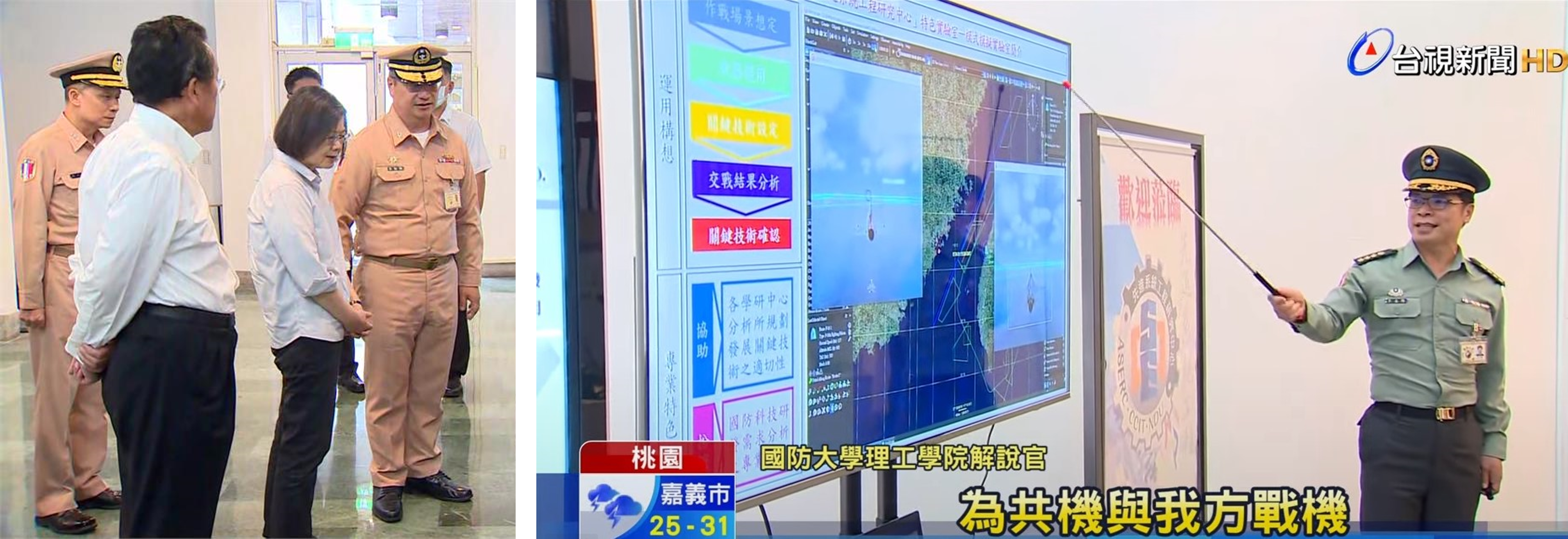
Back in 2020, the Chung Cheng Institute of Technology (CCIT) at the National Defence University in Taiwan chose MAK ONE, including VR-Forces, the MAK Data Logger, and the MAK RTI, to fulfill its defense research and development goals.
Fast forward to 2023 and CCIT relies on MAK ONE, now also including VR-Vantage, to build realistic wargaming scenarios to help train warfighters’ response to threats. In June 2023, the President of Taiwan, Tsai Ing-wen, visited the CCIT campus where she experienced a demonstration showing how CCIT’s Advanced Systems Engineering Research Center (ASERC) uses MAK ONE-based simulation technology to carry out research and development of new weapon systems.
Tsai Ing-wen saw a wargaming scenario based on VR-Forces of an air battle between Air Force fighters (blue) and PLA fighters (red) on the central line of the Taiwan Strait.
Here's a summary of the scenario:
The training scenario consists of an air battle engagement where the Red Fighters are conducting routine air training and the Blue Fighter team is in the airfield in standby mode. When the Red Fighters turn and approach the Taiwan Strait, the Blue Fighters are engaged for immediate take-off and implement “Rules of Engagement” to Hold-Fire.
The Blue Fighters broadcast a message to the Red Fighters to leave the area, but the Red Fighters respond by engaging a rocket attack on the Blue Fighters who respond with thermal flares. The Blue Fighters continue to monitor and follow the Red Fighters, who then enter the 12-nautical mile airspace, which changes the Blue Fighters' rules of engagement to Fire-at-Will. The Blue Fighters launch their rockets onto the Red Fighters who are hit and destroyed.
The illustrations shown below are the Blue Fighter in standby mode, the Red Team crossing the Taiwan Strait, and the Red Team subsequently being shot down.
Standby position.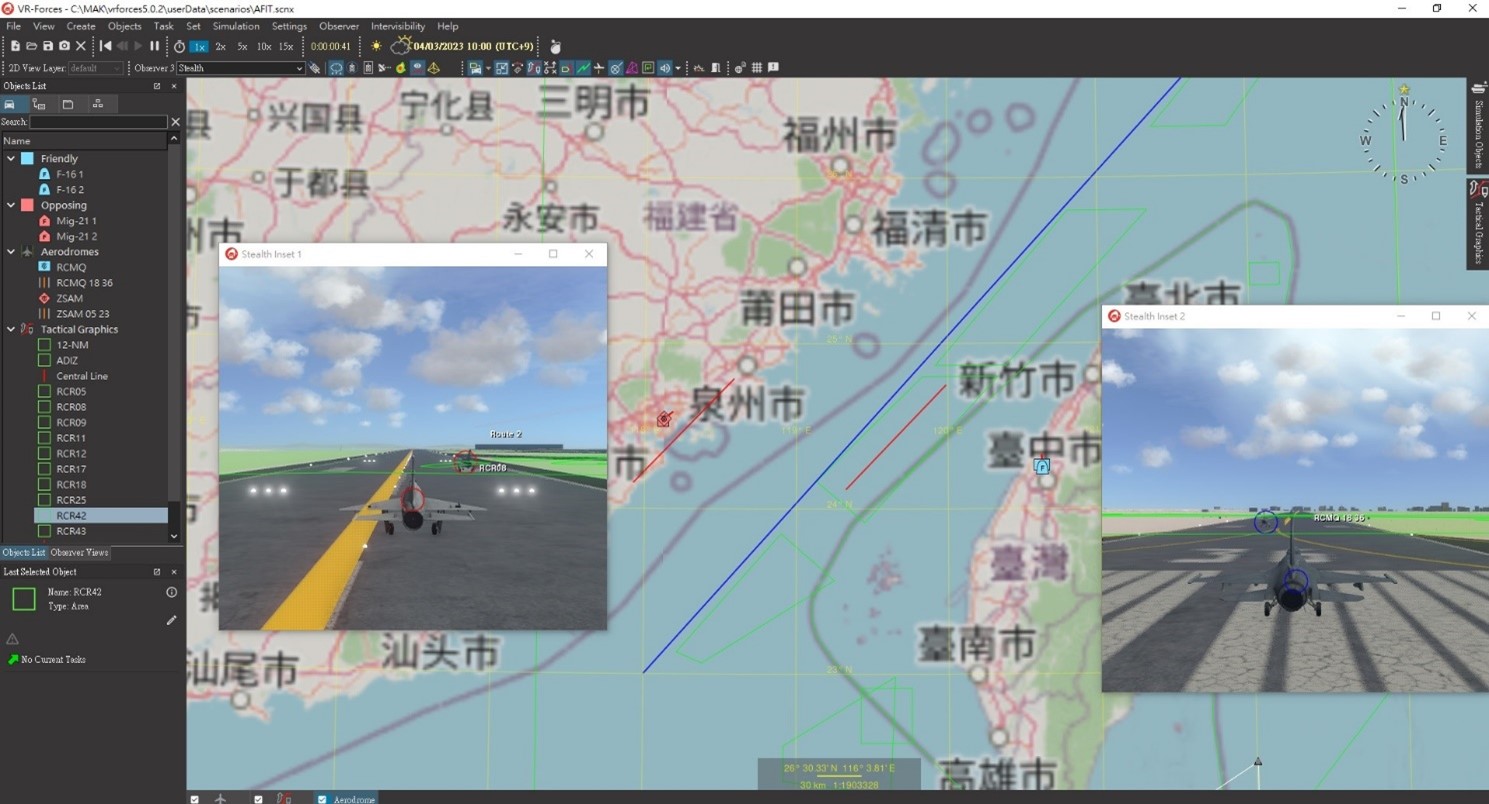
Red Team crossing the Taiwan Strait. 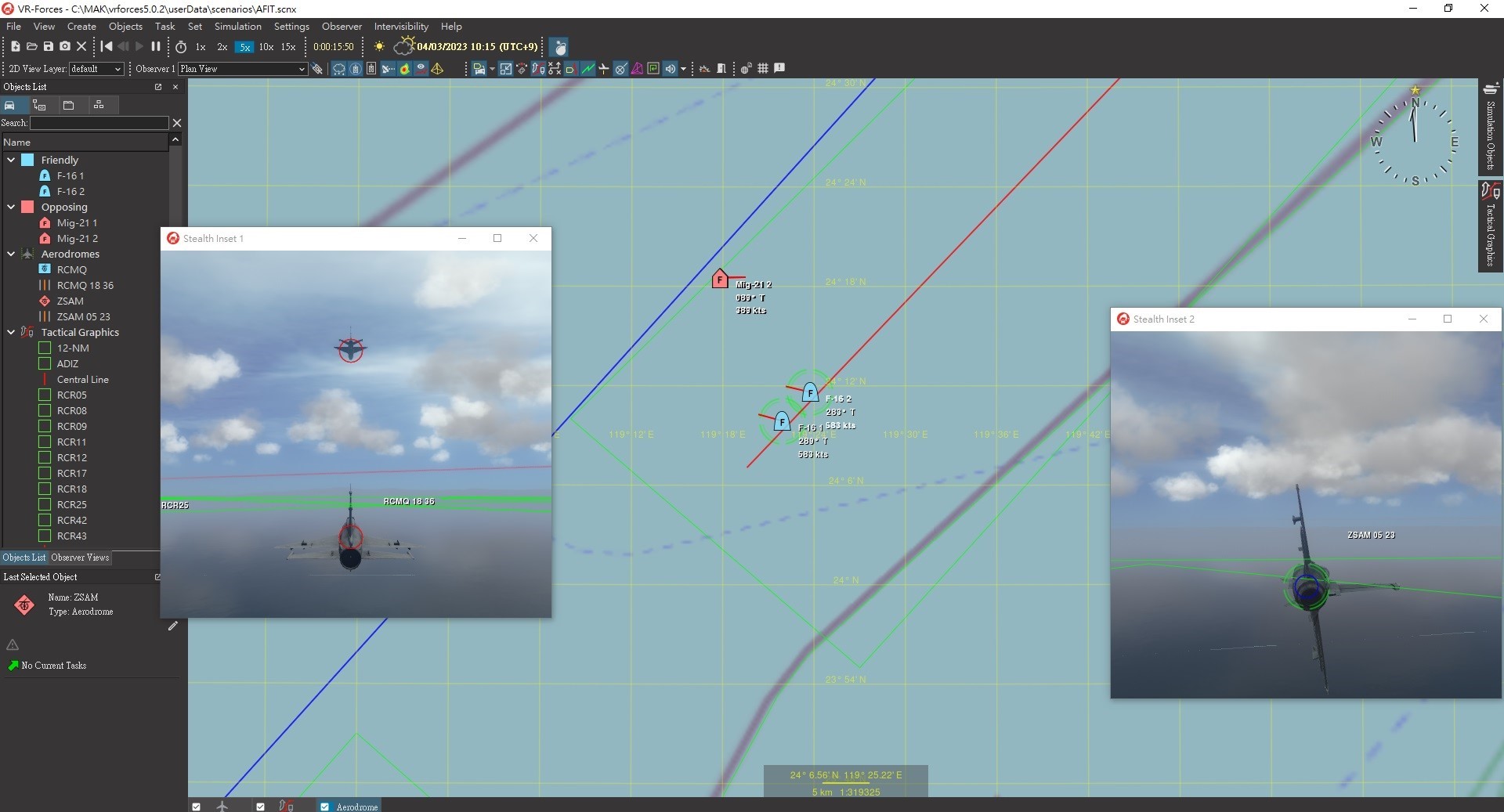
Target destroyed.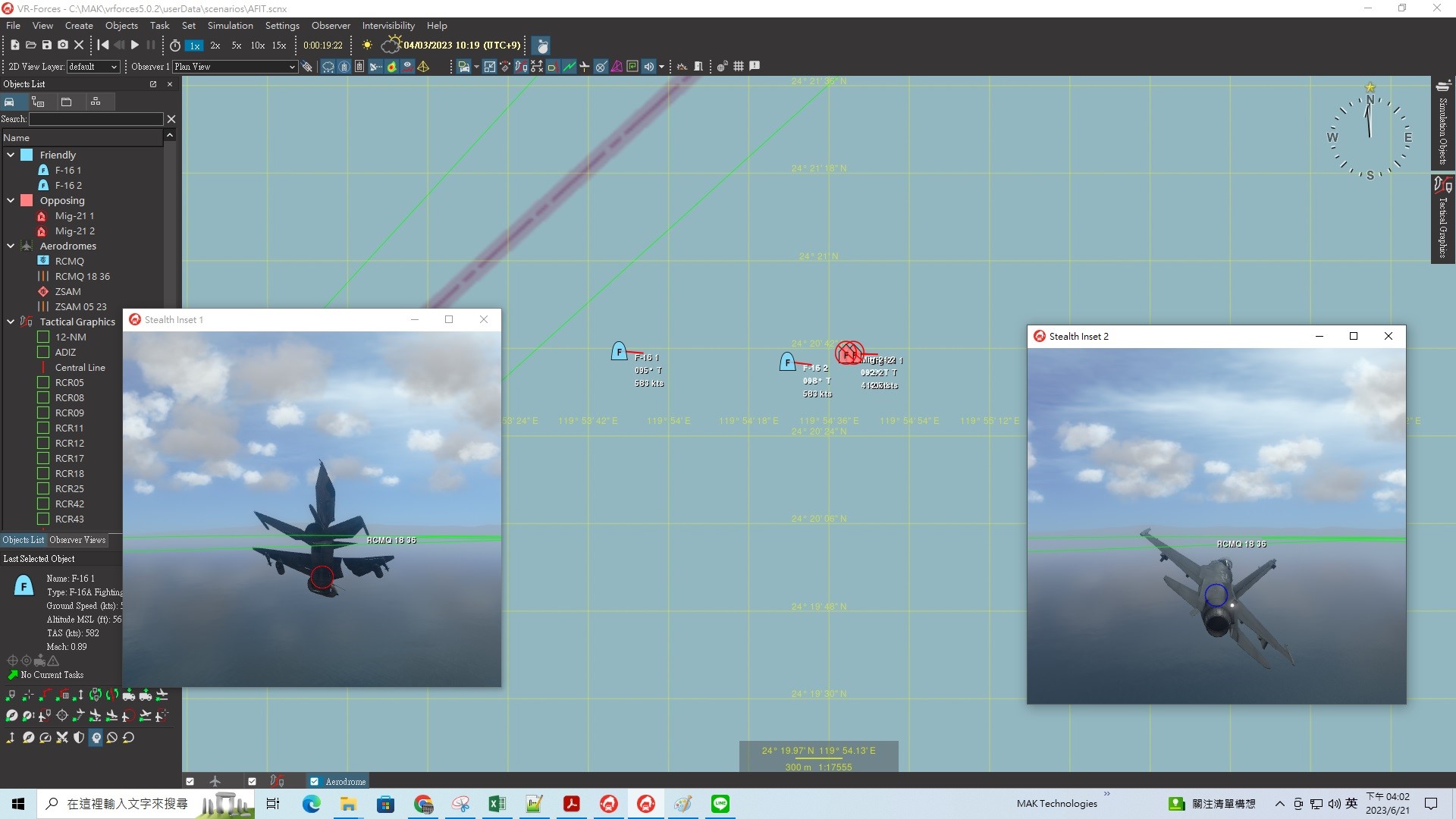
MAK ONE as the simulation platform of choice for CCIT ASERC
Preparations for national defense and homeland security are never-ending. With MAK ONE’s virtual platform that provides combatants with various possible threats, CCIT helps train warfighters’ response quickly and iteratively, while also allowing researchers to better understand the weapons and equipment needed so that decision-makers can formulate the best policies and investments.
When asked why MAK ONE was selected as the simulation platform of choice, Dr. Ryan Lee, Executive Officer of ASERC, explained, “During the simulation process with MAK ONE, we can choose different weapon settings and different key technologies and then analyze through the results of the engagement whether the key technologies we have developed can meet operational needs.”
ASERC and MAK ONE are looking forward to moving along this path together in the years to come.
To learn more about how the MAK ONE suite of simulation software can help you reach your simulation & training goals, get in touch with us at
 TMI Simulation Solutions Chooses MAK ONE for Light Combat Turret training simulation system
TMI Simulation Solutions Chooses MAK ONE for Light Combat Turret training simulation system
TMI Simulation Solutions chooses MAK ONE as the software solution for the Malaysian Army’s AV8 Light Combat Turret training simulation system
In March 2022, TMI Simulation Solutions was awarded a contract by Denel Land Systems (DLS) to deliver two AV8 Turret Training Simulators to train gunners, commanders, and drivers of the AV8 Gempita, an 8x8 Armoured Fighting Vehicle. With only a 12-month contract to finalize the training simulators – complete with simulation software, electro-mechanical hardware, and instructor operator stations – TMI hit the ground running on their search for reliable, high-performance simulation software that catered to contract requirements and was easy to modify.
TMI evaluated simulation software companies across the globe for the job, and even considered developing the software in-house…but ultimately chose the MAK ONE suite of simulation software from MAK Technologies. MAK ONE was the tried and tested set of simulation tools already used on several Light Combat Turret systems fitted to wheeled and tracked vehicles.
“MAK ONE’s database of extensive militarized aerial, naval, and terrestrial vehicle platforms reduced our technical risks and enabled us to deliver a world class solution in ten months from placement of order to installation onsite,” said Thivash Moodley, CEO of TMI Simulation Solutions.
TMI was able to easily create multiple missions, add terrain databases, and rapidly integrate radios, hand controls, battle panels, switch panels and other OEM specific hardware, which fast-tracked development and significantly reduced test and evaluation effort. The ballistics models for the machine guns, cannons, and missiles are based on models calibrated against extensive firing trials, which helped TMI incorporate “gun jump” to improve the hit-miss accuracy.
“TMI has designed and developed more than 100 complex multi-platform simulation systems over our 15-year history, but never have we exceeded our own expectations to complete a multi-vehicle, multi-role player simulation solution in 10 months – all thanks to MAK ONE and the MAK management and support teams,” said Mr. Moodley. “Thank you, MAK, for your invaluable contribution to help TMI deliver another successful global project. Our entire team is still awed by the speed, performance, and quality with which you helped us deliver these two turret training simulators.”
To learn more about how the MAK ONE suite of simulation software can help you reach your simulation & training goals, get in touch with us at
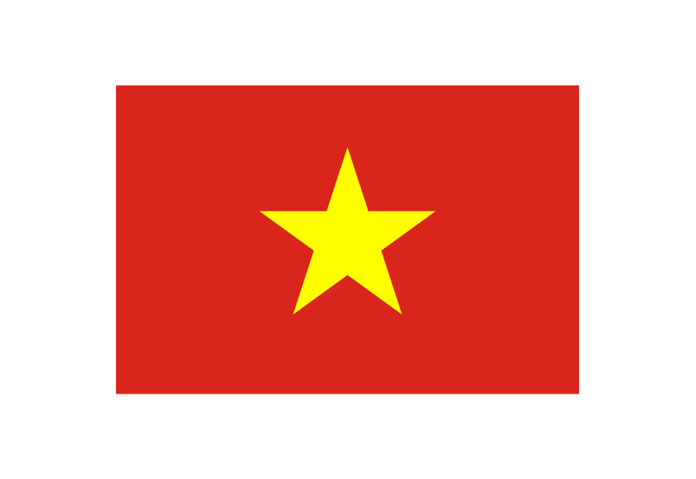 MAK ONE Technology Enhances Search and Rescue Missions in Vietnam
MAK ONE Technology Enhances Search and Rescue Missions in Vietnam
MAK ONE Technology Enhances Search and Rescue Missions in Vietnam
Le Quy Don Technical University is developing search and rescue (SAR) simulation-based training systems built with the MAK ONE suite of simulation tools, including MAK’s VR-Forces, VR-Engage, VR-Vantage, and the MAK Data Logger.
Vietnam is particularly vulnerable to natural disasters, and the impact of global warming is increasing the frequency and severity of disaster events. The Vietnamese government and partner organizations across the globe, including the University of Technology Sydney (UTS) and Le Quy Don Technical University (LQDTU), continue to devote enormous effort to improve Search and Rescue (SAR) missions during and post-disasters. The groups are embracing faster, better, and more efficient techniques – such as simulation technology – to improve training to make SAR activities safer, more effective, ultimately minimizing the often-tragic consequences of rescue efforts.
LQDTU leaned into MAK Technologies’ 30+ year simulation & training expertise and selected the MAK ONE suite of simulation tools as the platform for the simulation-based SAR training systems in development alongside UTS and the Vietnamese government.
For this SAR project, LQDTU is using MAK’s powerful and flexible VR-Forces, a computer-generated forces (CGF) platform to build the simulated SAR environments and fill them with the appropriate urban, maritime, and airspace activity for the training missions. VR-Engage, MAK’s multi-role virtual simulator, allows trainees to play the role of a first-person human character in the SAR simulations – for example, a vehicle driver, the pilot of an aircraft, or a sensor operator. VR-Vantage is providing the 2D and 3D out-the-window (OTW) view from the simulated entities. Lastly, the MAK Data Logger records and plays back the SAR scenarios for analysis and After-Action Review (AAR) to help trainees and instructors gauge mission success and plan future missions.
"We found that MAK ONE is a good simulation solution for coordination training – it is easy to set up a training system with flexible configuration," said Dr. Kien Trung Nguyen from LQDTU.
To learn more about how the MAK ONE suite of simulation software can help you reach your simulation & training goals, get in touch with us at
Interested in getting up to speed on the integral pieces of a simulation and their levels of fidelity? See The Tech-Savvy Guide to Virtual Simulation. Interested in a demonstration?
 Boeing Phantom Works Uses MAK'S VR-Vantage Image Generator
Boeing Phantom Works Uses MAK'S VR-Vantage Image Generator
Boeing Phantom Works chooses MAK's VR-Vantage image generator for reconfigurable cockpit simulator
Boeing has purchased a MAK ONE Enterprise license that allows them to use VR-Vantage IG in a reconfigurable cockpit simulator in five Phantom Works sites worldwide.
Phantom Works, the advanced research and development unit for Boeing, has purchased a MAK ONE Enterprise license for VR-Vantage IG. MAK ONE licensing can be configured to suit an organization's size, shape, and preferred licensing model. Phantom Works is taking advantage of MAK ONE to license VR-Vantage IG for use inside reconfigurable cockpit simulators in five separate sites worldwide.
Phantom Works is the latest in a surge of customers who are taking advantage of the new improvements in VR-Vantage IG to meet their visualization needs at a lower cost than a typical high-end image generator.
VR-Vantage IG provides Phantom Works with a unique set of image generation capabilities.
MAK’s VR-Vantage IG software is used to render out-the-window scenes for first-person simulators. Its open architecture was designed from the ground up to offer the most flexible, high-performance visualization tools on the market.
VR-Vantage IG can procedurally generate terrain directly from source data including elevation, imagery, land use classification, and features. It also allows for procedural generation of textures from land use data, which provides higher effective resolution and eliminates artifacts such as baked-in shadows, cars, and trees. Textures for each land-use classification can change based on season and location. VR-Vantage IG can auto-material classify global terrains based on land-use data and feature data to enable accurate infrared sensor views.
VR-Vantage IG is capable of procedural generation of airports from X-Plane/ Digital Aeronautical Flight Information File airport descriptions, including geo-specific runways, markings, taxiways, signs, and lights. It also generates millions of trees and other vegetation directly on the GPU, based on land use rasters or aerial features.
Customers can use VR-Vantage IG to create and render high-performance buildings, roads, etc. based on OpenStreetMap data for the whole world, including cut-in roads. They can also procedurally add detail and quality to the world by adding procedural geometric noise to the elevation data, and by adding convincing bump maps based on the slope and elevation of mountains.
Built-in support for DiSTI’s GL Studio allows customers to build and prototype various cockpit instruments and tactical systems, critical for deploying reconfigurable flight simulators.
VR-Vantage IG continues to expand its capabilities, and in turn, its market share. It is built to be deployed on a variety of COTS hardware configurations from simple desktops to multi-channel displays for virtual cockpits, monitor-based training systems, and AR/VR components. VR-Vantage IG APIs make it possible to accommodate any training, simulation or mission rehearsal requirements. This approach also supports compatibility with current, existing applications.
Want to learn more about the integral pieces of a simulation and their levels of fidelity? See The Tech-Savvy Guide to Virtual Simulation. Interested in a demonstration?
 Over Twenty Years of Working With the UK MOD, and Still Going Strong
Over Twenty Years of Working With the UK MOD, and Still Going Strong
Over twenty years of working together, and still going strong
Jonathan Searle, a Cranfield University Academic, responsible for the delivery of modeling and simulation to the UK MOD, at the Defence Academy of the UK, shares his own personal insights into the strong relationship between the Defence Academy’s Modelling and Simulation (M&S) program, Antycip Simulation, and VT MAK.
The M&S program teaches at the postgraduate level the principles, technologies, and applications of defense modeling and simulation. The program deploys training in a Simulation and Synthetic Environment Laboratory (SSEL) which was designed specifically to support education through classes, labs, case studies, and projects.
Set up in the mid-Nineties, the SSEL was equipped with a number of SGI-based desktop reconfigurable generic vehicle simulator stations, in which the 90’s iterations of MAK’s products, ![]() VR-Link,
VR-Link, ![]() MAK Data Logger, and
MAK Data Logger, and ![]() VR-Vantage, played a vital role.
VR-Vantage, played a vital role.
Right at the beginning of Antycip Simulation’s history, the relationship with Jonathan Searle and Defence Academy began. Antycip Simulation partnered with MAK in Europe, taking on the supply and specification of the products, and additionally inherited the responsibility for support and maintenance of the MAK solutions with Defence Academy’s desktop simulators.
Searle comments, “It’s been a positive relationship from the start. I already knew Chris Waldron (now UK Regional Manager at Antycip Simulation) from a previous role so that helped initially. Plus, it’s very helpful to have access to people who are experts in the MAK tools that are nearer than the US: that is, nearer physically - in terms of us visiting Antycip Simulation and vice versa; and nearer in terms of time-zone and therefore responsiveness.”
“Antycip Simulation has the added advantage of understanding our customer base – the UK Ministry of Defence (MOD). Also, Antycip Simulation occupies a privileged position in terms of its knowledge of the domain in which we work and its activities. Where appropriate we’ve been able to leverage that perspective to our students.”
Over two decades on, much has changed in MOD defense strategy which, in turn, has changed its needs from simulation and modeling training. To meet this the SSEL and the Defence M&S educational programs have evolved and in this evolution, have continued to be supported by the strong relationship that exists between Defence Academy, Antycip Simulation, and MAK. Searle points out, “MAK products – with Antycip Simulation input and expertise – have played a part in that [journey] all the way along.”
As a measure of that relationship’s strength, SSEL now has licenses for most of the MAK product portfolio, including; ![]() VR-Exchange,
VR-Exchange, ![]() MAK WebLVC Server,
MAK WebLVC Server, ![]() MAK RTI,
MAK RTI, ![]() VR-Forces, and
VR-Forces, and ![]() DI-Guy, as well as the original three products that were used right back at the start – VR-Link, MAK Data Logger, and VR-Vantage Stealth. All of which are supported by the technical expertise in MAK products, by Antycip Simulation’s UK team near Oxford (about an hour’s drive from the Defence Academy in Shrivenham)
DI-Guy, as well as the original three products that were used right back at the start – VR-Link, MAK Data Logger, and VR-Vantage Stealth. All of which are supported by the technical expertise in MAK products, by Antycip Simulation’s UK team near Oxford (about an hour’s drive from the Defence Academy in Shrivenham)
Looking to the future, Searle outlines his goals for the Defence academy, which centers around giving students the opportunity to see and use current representative tools and applications and also to find opportunities to get the industry perspective across to MOD students and vice-versa.
Searle states he would also like to, “work with people who understand education and its value.” This goal is particularly pertinent as Defence Academy educates MOD and industry personnel who will go on to be decision-makers, who will in turn have a hand in the Academy’s future trajectory.
Note: In contributing to this article Jonathan Searle was not commenting on behalf of the MOD, the Defence Academy of the UK, or Cranfield University.
Want to learn more about the integral pieces of a simulation and their levels of fidelity? See The Tech-Savvy Guide to Virtual Simulation. Interested in a demonstration?
 Elettronica and Antycip Simulation Electronic Warfare Battlelab
Elettronica and Antycip Simulation Electronic Warfare Battlelab
Elettronica and Antycip Simulation choose MAK software for Electronic Warfare Battlelab
Electronic warfare refers to the ability to use the electromagnetic spectrum to sense, protect, and communicate in theater, most notably through radar and communications. In order to gain an edge in Electronic Warfare, militaries around the world are looking to better detect, understand, and respond to the use of electronic systems.
In order to maximize electronic warfare outcomes, training systems are needed to simulate a tactical environment within which teams can learn the tactics, techniques and procedures involved.
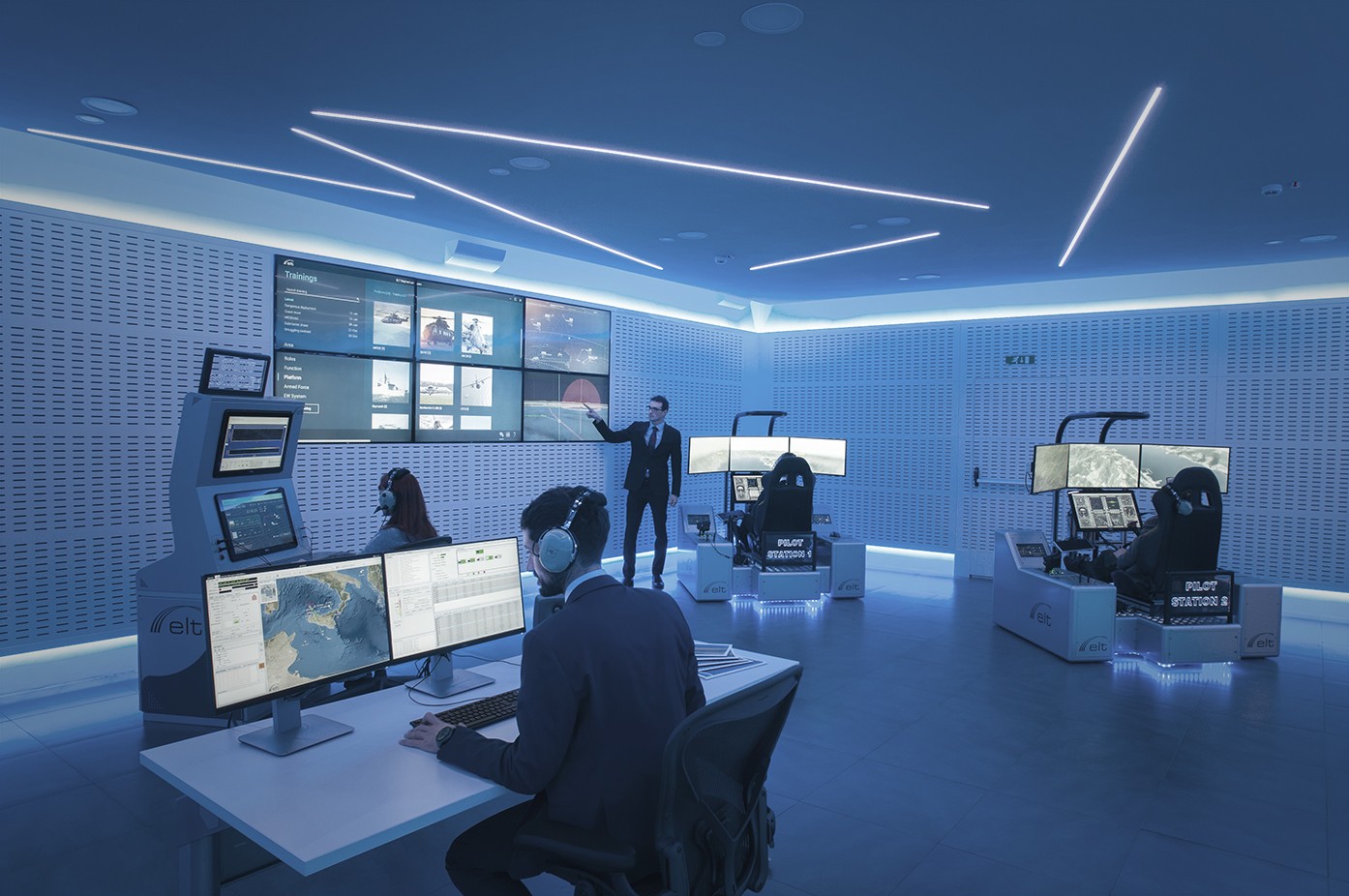
In response to this ambitious challenge, Elettronica SpA, a leader in the field of Electronic Counter-Measures, has teamed with VT MAK and Antycip Simulation to develop the Electronic Warfare Battlelab. The Electronic Warfare Battlelab is a multi-role, multiplatform, joint-force training arena designed to conduct leading edge joint mission exercise sessions that focus on electronic warfare.
Inside the Battlelab, there are six intelligence stations (two electronic intelligence, one communications intelligence, and three reconfigurable workposts), along with an Intercom communications system to populate audio traffic. Connected to the network are two pilot workstations and one Command & Control Student workstation. An Instructor Operator Station (IOS) serves as a supervision system and delivers visualization and insights to instructors and observers. The IOS station works in tandem with a CGF to supply tactical scenario generation, electromagnetic environment generation. A workstation is dedicated to visual database/3D model generation. An HLA communication infrastructure ties the entire system together.
Antycip Simulation assisted Elettronica in determining the best software to bring the system to life, and they chose MAK.
- VR-Forces powers the IOS, the CGF, and provides a 2D Map view of the simulation for the video wall.
- VR-Vantage and the MAK Data Logger work in tandem to provide 3D views for after-action review.
- VR-Engage serves as the base of the two pilot stations.
- The MAK RTI serves as the backbone of the communication infrastructure.
This software arrangement powered the system while retaining maximum flexibility and extendability for future evolutions of the setup.
The resulting system is capable of training tasks at the individual level as well as complex coordination actions required of multi-echelon joint-force operations. This enhanced collaboration between different roles and forces creates a more nuanced and beneficial simulation.
“Antycip played a huge role in the success of this project by consulting for the software architecture definition, training Elettronica’s software developers, and helping to select the correct software products,” Enrico Fazio, Head of Customer Support Engineering at Elettronica. “They supported the installation and helped to integrate the Elettronica software modules. With the aid of Antycip, we chose MAK software because the flexibility of its COTS solutions gave us the widest range of options, making it the most appealing for our architecture.”
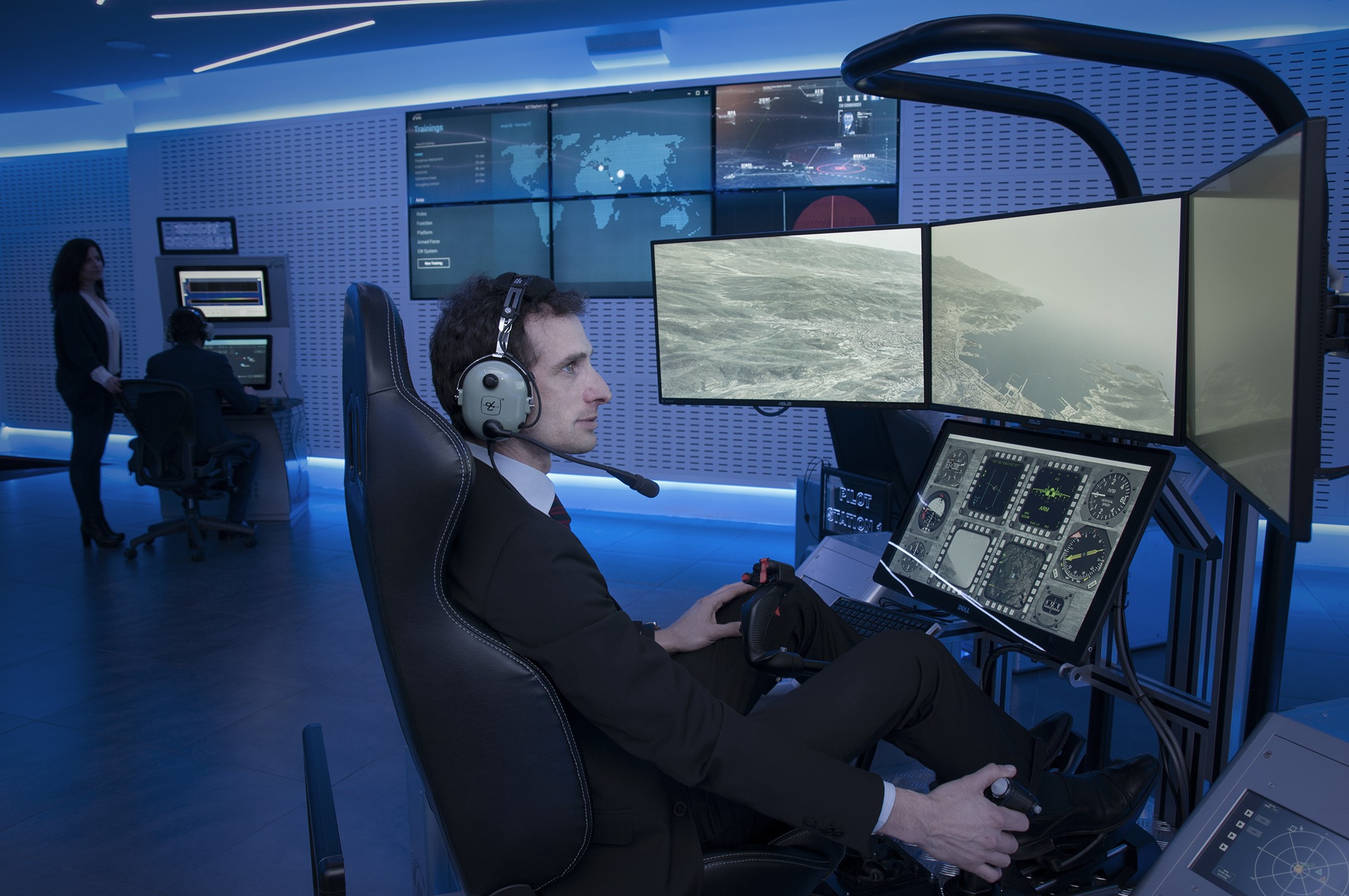
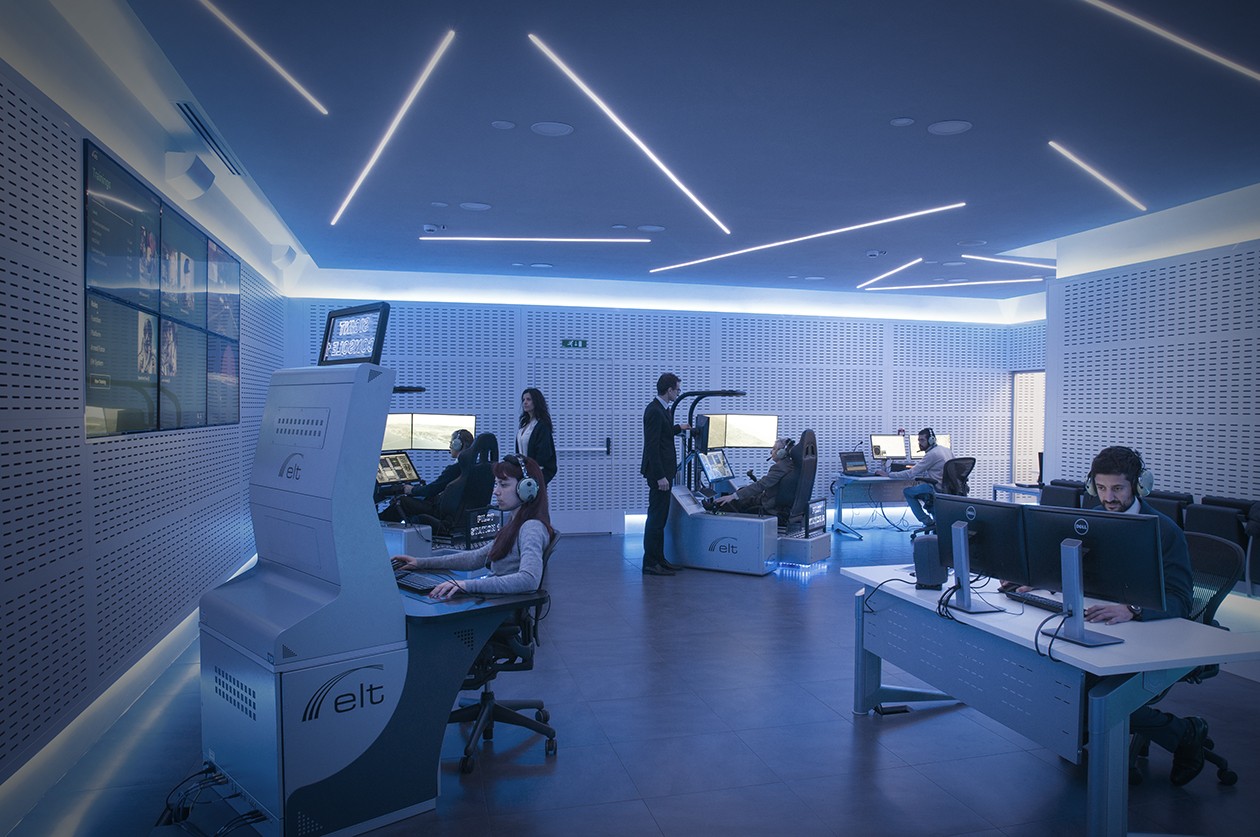
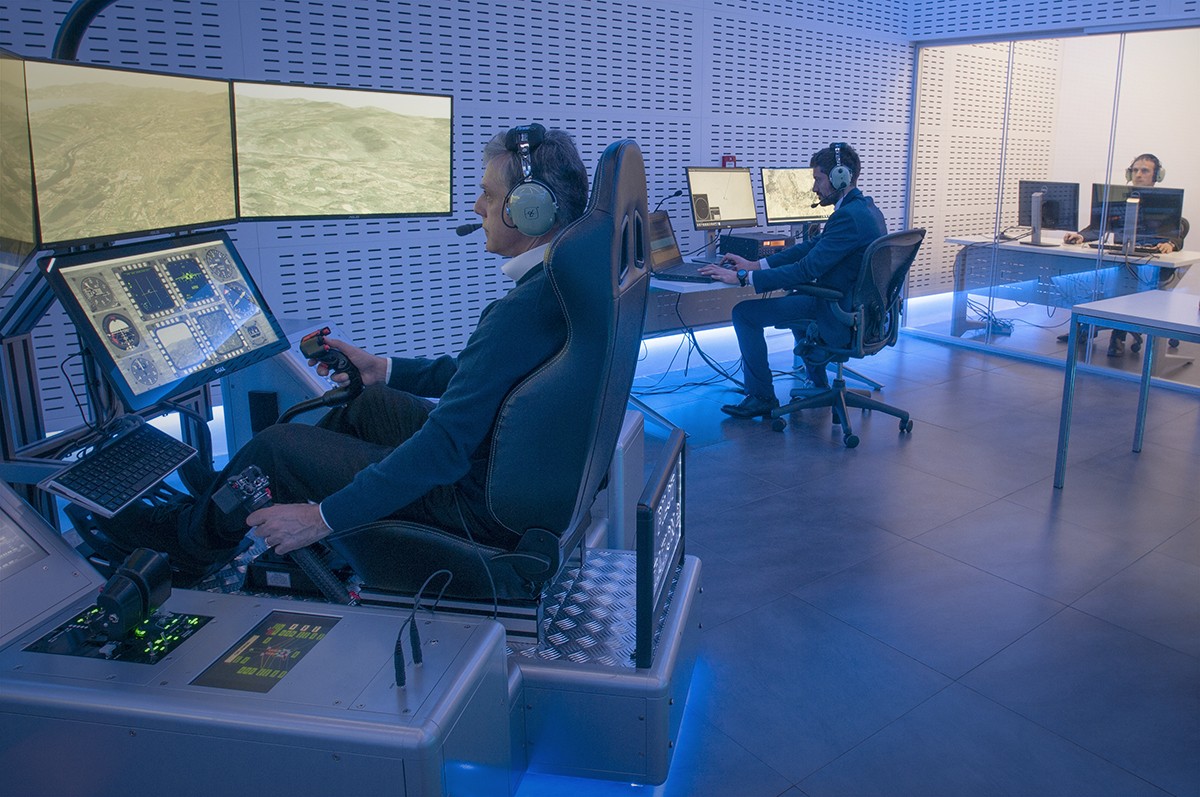
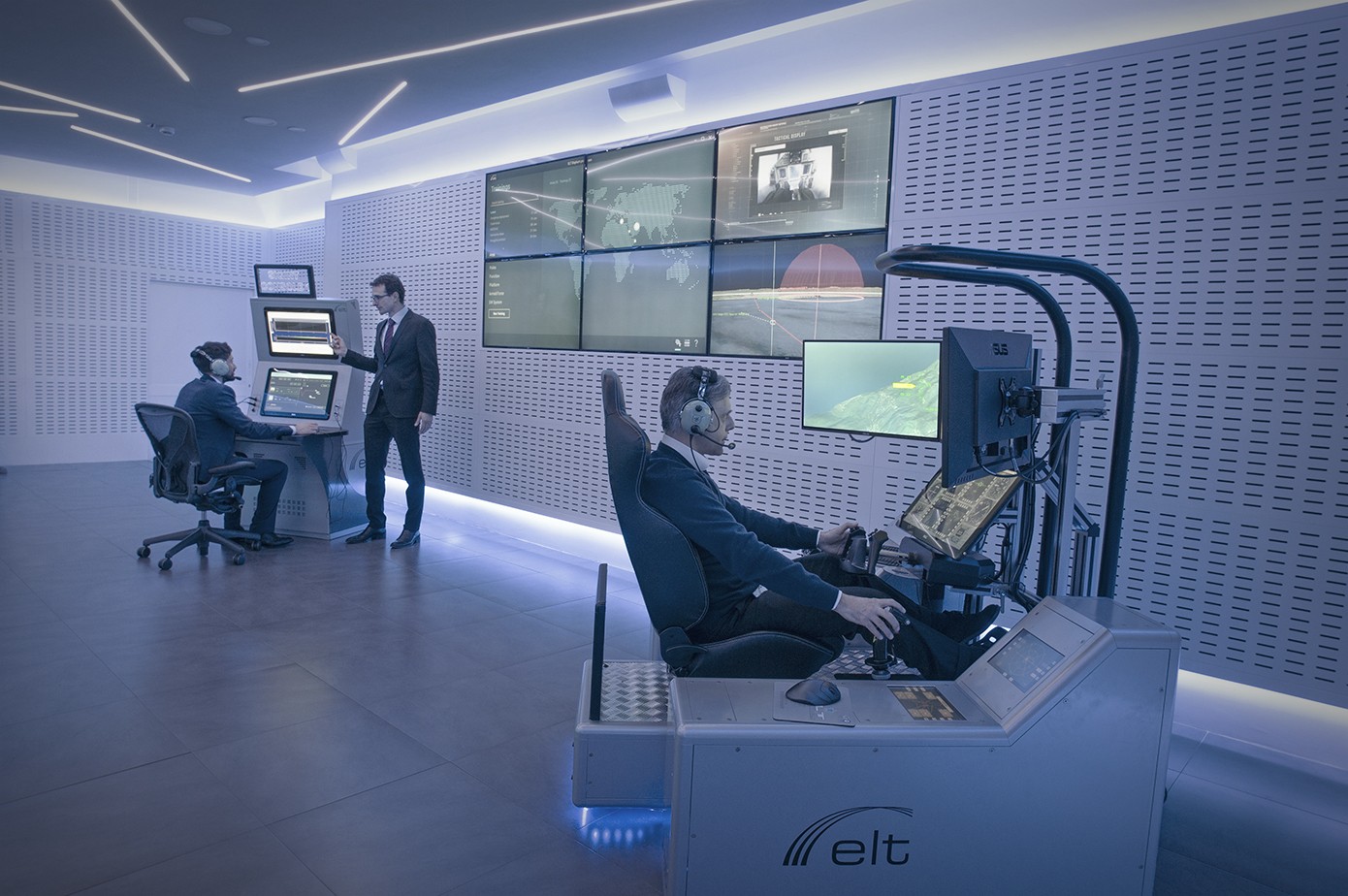
Want to learn more about the integral pieces of a simulation and their levels of fidelity? See The Tech-Savvy Guide to Virtual Simulation. Interested in a demonstration?
 Infiniti Chooses MAK ONE for Elite Forces Training, featuring VR-Engage
Infiniti Chooses MAK ONE for Elite Forces Training, featuring VR-Engage
Infiniti Chooses MAK ONE for Elite Forces Training, featuring VR-Engage
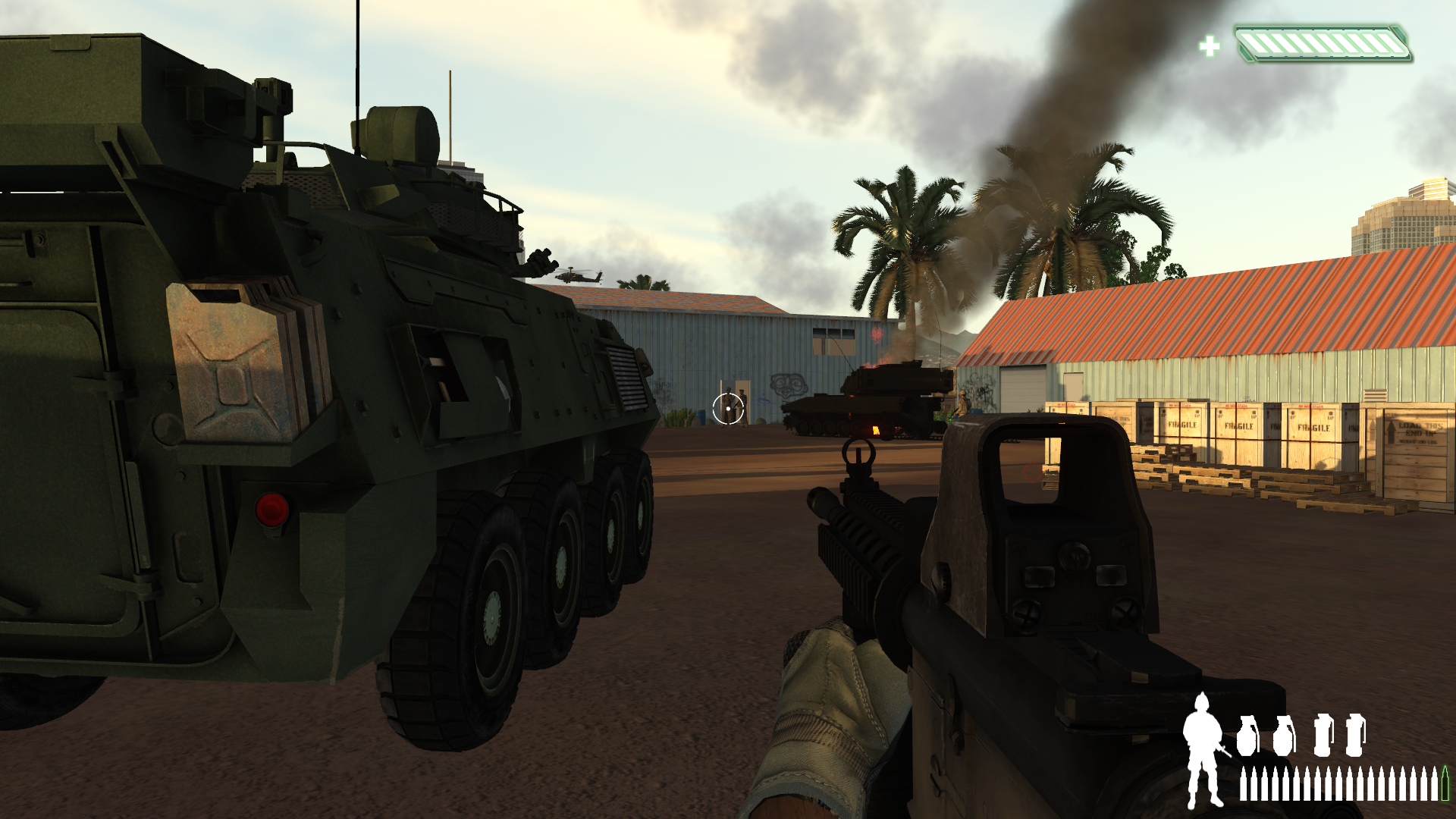
Elite forces are always looking for an edge, and the quality of the training they receive can be the difference between emerging victorious or failing completely. While nothing can perfectly replicate getting one’s boots on the ground, superior first-person training systems can give a trainee a more lifelike experience that can be directly applicable in the field.
With that in mind, Jakarta-based PT. Infiniti Reka Solusi (Infiniti) has chosen to use the entire suite of MAK simulation software, including ![]() VR-Engage, MAK’s first-person simulator, as the core of an improved multi-level training system for elite forces. Trainees are now immersed in a complete simulation software system, yielding productive results.
VR-Engage, MAK’s first-person simulator, as the core of an improved multi-level training system for elite forces. Trainees are now immersed in a complete simulation software system, yielding productive results.
The suite Infiniti chose centers on VR-Engage, a multi-role virtual simulator that lets users play the role of a first-person human character; a vehicle driver, gunner, or commander; or the pilot of an airplane or helicopter. The Infiniti system is a hybrid of command and staff and role player stations. The VR-Engage-powered role player stations interact with a synthetic ![]() VR-Forces simulation to provide a complete training experience. Infiniti takes advantage of the customizability of VR-Forces, specifically tailoring it for their clients, including adding and extending specific functionalities.
VR-Forces simulation to provide a complete training experience. Infiniti takes advantage of the customizability of VR-Forces, specifically tailoring it for their clients, including adding and extending specific functionalities.
Infiniti is looking to revolutionize the military training experience and generate massive improvements in outcomes.
“Our project’s goal is to re-engineer the way the military conduct their training starting from the squad level up to command and staff,” said Firman Arifman, CEO at Infiniti. “It will greatly accelerate the decision-making process, improve the situational awareness, enhance the coordination and communication, reduce cost; enabling experimental exercises, problem-solving, and providing the data and information for reviews and future improvements.”
Infiniti is pairing VR-Engage and VR-Forces with ![]() VR-Vantage IG for a common operational picture,
VR-Vantage IG for a common operational picture, ![]() WebLVC Suite for browser-based simulation access,
WebLVC Suite for browser-based simulation access,![]() VR-TheWorld Server for a web-based streaming terrain server, and
VR-TheWorld Server for a web-based streaming terrain server, and ![]() DI-Guy SDK to power realistic human activity.
DI-Guy SDK to power realistic human activity.
To link the system together, Infiniti will use the ![]() MAK RTI to connect HLA federates and exchange simulation data. The
MAK RTI to connect HLA federates and exchange simulation data. The ![]() MAK Data Logger is used for recording and replay.
MAK Data Logger is used for recording and replay.
“MAK products greatly improve the speed of development and reduce our time in delivering our solution,” said Arifman. “They also enable us to extend the functionalities relatively easily to suit our client requirements.”
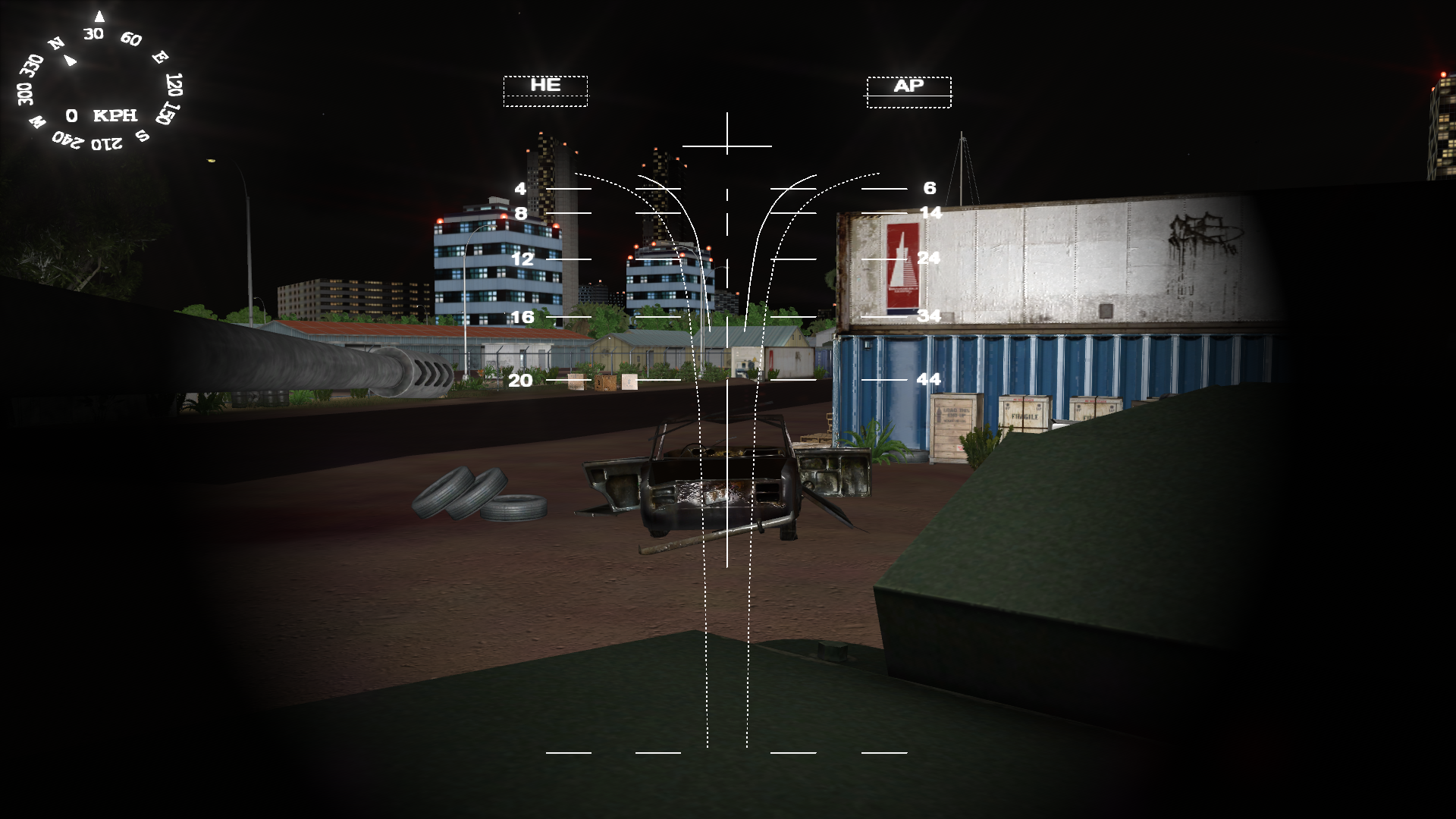
VR-Engage allows for first-person training as vehicle gunner.
For Infiniti, detailed and thorough documentation, open architecture, and customizability set MAK apart from competitors, and embracing MAK’s unique “engineer-down-the-hall” approach has resulted in a superior technical support experience.
“MAK’s technical support is very supportive and responsive,” said Arifman. “All of our questions were solved and answered in detail and with examples if necessary. What we love is the actual engineer that knows the matters that answer our query.”

VR-Vantage provides a rich view into the simulated world.
Bolstered by the positive experience it has had with MAK, Infiniti now plans to add Oculus Rift and motion platforms, as well as networked inertia and orientation sensors to its role player stations for an even more immersive experience.
Want to learn more about the integral pieces of a simulation and their levels of fidelity? See The Tech-Savvy Guide to Virtual Simulation. Interested in a demonstration?
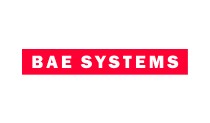 BAE Systems Uses MAK ONE to Simulate Intelligent Defense Systems
BAE Systems Uses MAK ONE to Simulate Intelligent Defense Systems
BAE Systems, CNIR Saves 6 to 12 Months of Development
Time Using MAK ONE
BAE Systems, Communication, Navigation, Identification and Reconnaissance (CNIR) is using a suite of tools from MAK Technologies on various Internal Research and Development (IRAD) projects and in support of major defense programs such as Joint Tactical Radio System (JTRS), Warfighter Information Network — Tactical (WIN-T), Future Combat Systems (FCS) and Airborne/Fixed/Maritime (AMF) — JTRS.
To simulate intelligent defense systems that are network-centric and contain large-scale sensor networks, BAE models and simulates different parts of these systems using a variety of different tools that combine the effects of battlefield communications networks, mobile ad-hoc networks (MANETs), UAV relays, etc., on traditional theatre of engagement scenarios. Their biggest challenge was integrating the diverse tools to create a comprehensive simulation.
CNIR chose VR-Link, the MAK RTI, VR-Forces, VR-Vantage, and the MAK Data Logger to build the simulation and visualization solution they needed.
"MAK's products saved us the time of building our own custom applications without sacrificing any of our simulation requirements,” said Walter Whimpenny, Project Lead, Modeling & Simulation. “It would have taken anywhere from six months to a year to develop the capability we wanted on our own. MAK’s off-the-shelf products have provided a well-developed solution that still allows us the flexibility to customize it as we see fit."
Using OPNET to model communications effects with VR-Forces, BAE is able to simulate the effects of communications on the result of a battle. For example, when an entity modeled in VR-Forces needs to issue a call for fire to another entity, instead of just passing the call-for-fire message directly to the intended recipient, it sends a query to OPNET, through HLA. OPNET receives this query and calculates whether the message arrives at its intended destination and if so when depending on modeled factors that may affect the communications (e.g., distance, weather, terrain, line of sight, routing algorithms, jamming, presence of relays, etc.).
“MAK’s products were by far the most flexible and easily integrated tools we found,” said Matthew Boyer, Modeling & Simulation Engineer.“The products provided us with the simulation and visualization solution we needed. The robustness of the tools and the ease with which they were integrated with other tools was a huge time saver.”
“With MAK’s tools, we had immediate out-of-the-box capability, but retained the flexibility we need to customize the software to fit our needs,” said Walter Whimpenny. “With their quality technical support, we knew we had someone to turn to when integrating all the diverse tools we chose.”
On multiple occasions, BAE turned to MAK’s technical support for help integrating the products with other simulation tools in their custom environment. MAK also provided technical experts at the BAE facility to both train and work with BAE engineers to address specific technical hurdles.
BAE Systems, Communications, Navigation, Identification & Reconnaissance (CNIR) is a unifying force with technically superior solutions that transform the armed forces’ communication, situational awareness, mobility, and mission expertise. Their technical expertise includes C3I systems, communications systems integration, guidance and navigation, electronic identification, airborne ground-based software development, and modeling & simulation. CNIR is at the forefront of innovation, working to develop the next generation of intelligent systems.
Want to learn more about the integral pieces of a simulation and their levels of fidelity? See The Tech-Savvy Guide to Virtual Simulation. Interested in a demonstration?
 Air Force Test Pilot School Upgrades to VR-Vantage IG
Air Force Test Pilot School Upgrades to VR-Vantage IG
The Air Force Test Pilot School Upgrades to VR-Vantage
VR-Vantage helps Calspan double the value of flight tests to both train test pilots and collect data for industry partners.
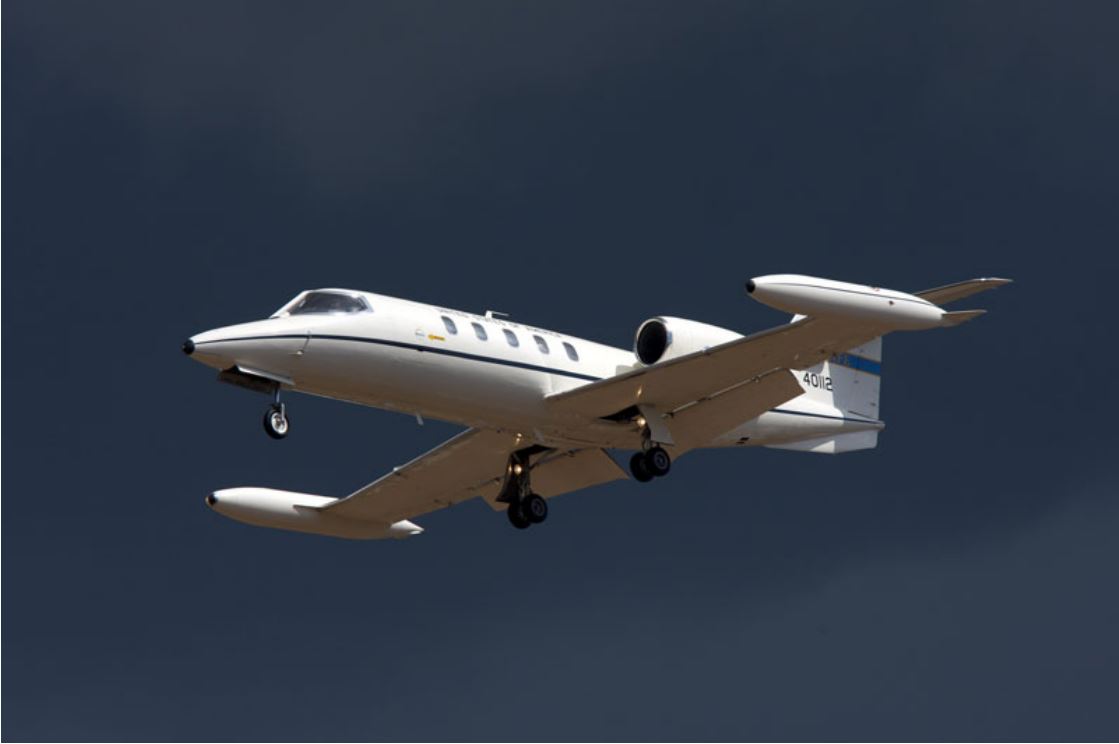
After the Flight Sciences Simulator was upgraded to use VR-Vantage, we got a chance to catch up with Jay Kemper, Senior Software Engineer at Calspan. We discussed how MAK’s VR-Vantage is used by the Air Force Test Pilot School and what they are learning using the VR-Vantage product.
“MAK supports the Air Force Test Pilot School at Edwards AFB with VR-Vantage; an image generator product. VR-Vantage has been used in the Flight Sciences Simulator to train the next generation of test pilots in everything from aerodynamics to flight control design”, said Mr. Kemper. Students have a one-year curriculum and they run courses starting every six months so there is a six-month overlap in the programs. A physics-based flight simulation model is used to learn the effects of aerodynamics. For example, they halve or double the effects of one of the flight controls so the pilot can experience the effects on the performance and maneuverability of the aircraft.
Each class has a capstone event which is a flight test. A flight test is a controlled experiment where most of the flight conditions are known (controlled) and specific characteristics are varied so they can be measured to collect data and learn about the effects of the variable. The school has moved beyond using the flight tests as just training exercises, now they are also partnering with industry leaders (e.g. Cessna and Lockheed) to perform tests as needed for research and development. It’s a win-win — the school gets to learn flight testing skills and the industry obtains valid flight test data.
“One of the most advanced uses of the simulator is to connect it to a programmable aircraft and use the simulator as a ground cockpit”, said Mr. Kemper. Calspan is studying issues with unmanned aircraft systems, e.g. the effects of delays in satellite communication relays. The Calspan test aircraft is a Learjet 25 with a four-man crew. The aircraft has a programmable flight control system, enabling the crew to get the plane into a controlled situation, then turn control over to the ground station to carry out the test. The ground control station can land the Learjet while the crew stands by with emergency override control in case anything goes wrong. “VR-Vantage uses the data from the aircraft to generate the scenes of the terrain to a very high degree of accuracy, allowing for an aircraft to be landed with no video stream”, said Mr. Kemper. The aircraft sends position, orientation, and status data to the ground station using a C-Band radio, and Calspan can get update rates up to 60 Hz. The terrain database was built by AFRL using TerraVista (TerraPage format).
Calspan is working with the UAS community to help set standards for how to test UAS, as simulation is always an integral part of flight testing. The flight test is the important part because the simulation can remove some, but not all doubt. By using the “Workload BuildUp Approach”, simulation can be used to run many iterations and flush out problems.
When asked about MAK’s support, Mr. Kemper said, “The support MAK gives is second to none, response time of its salespersons and support has been fantastic. They have gone above and beyond to facilitate their products to fit our needs, from getting licenses to product to plugin support. I’ve even asked about how to perform a certain task in a plugin, and the support responded with a full code that I could just drop in and build!”
Want to learn more? Have a look at the VR-Vantage page for more information. Are you interested in seeing a demonstration?
 Cincinnati Children’s Sport Training and Evaluation uses DI-Guy for Sport-Specfic Scenarios
Cincinnati Children’s Sport Training and Evaluation uses DI-Guy for Sport-Specfic Scenarios
Cincinnati Children’s Hospital Medical Center - Division of Sports Medicine Uses DI-Guy to Create Sport-Specific Scenarios for Training and Evaluation
It can take an athlete up to 18 months to return to sport after a torn ACL; even after surgical reconstruction and physical therapy, the athlete has up to a 30% chance of sustaining a second injury. Additionally, athletes have between a 50-100% chance of developing osteoarthritis within 20 years of their initial injury. Prevention of these types of injuries is key and it is especially important to know when it is safe for athletes to return to sport after such an injury.
The TEAM VR (Training Enhancement and Analysis of Movement Virtual Reality) Laboratory in the Division of Sports Medicine at Cincinnati Children’s Hospital Medical Center is leading the development of virtual environments to objectively quantify the progress of injury prevention training and physical therapy so that adolescent athletes can perform at a high level. TEAM VR has chosen MAK’s DI-Guy human simulation software to help create sport-specific scenarios for training and evaluation.
TEAM VR’s virtual environments aim to give physicians, physical therapists, athletic trainers, practitioners, and strength and conditioning specialists the tools to accurately measure the biomechanics of a child athlete (joint movements, strength, or flexibility for example) by actively engaging him/her in realistic, immersive sport scenarios; these scenarios are performed in a virtual environment that mimics competition on the field/court of play. The TEAM VR laboratory is equipped to utilize virtual environments for knee injuries, as well as concussion prevention. It can also be used as an education simulation center to help sideline first responders like athletic trainers and team physicians gain experience with sideline injury scenarios.
The TEAM VR environment is different than computer-assisted virtual environments (CAVE ) in that the participants are not tethered to the equipment and are able to move naturally over the ground without the use of a treadmill. It is fully integrated into the world-renowned Human Performance Laboratory and utilizes 35 motion capture cameras to detect the location of the athletes. Athletes wear a head-mounted display to transmit the virtual environment via a customized wireless video system that updates the display in close to real-time. The virtual environment will use DI-Guys to represent opponents, teammates, and coaches/instructors. The goal is to get the athletes actively playing the sport so that clinicians can measure modifiable injury-risk biomechanics to enhance movement adaptations and provide feedback in a safe, controlled space.
Of course, the athletes are not actually kicking, throwing, or catching balls: the time lag of present VR systems does not allow for such things. Rather, unique scenarios are created to mimic portions of sport-specific maneuvers such as the approach, jump, and land during a basketball rebound.
While the athlete does not actually experience the feedback of interacting with a physical ball, the athlete is immersed in such a way that he or she must respond and adapt to the movement patterns of teammates and opponents in the scenario, and even the flight of the ball. Thus the virtual environment provides a safe space for the athlete to push to a higher level, while simultaneously training him/her to better attend and react to the constant change of their surroundings.
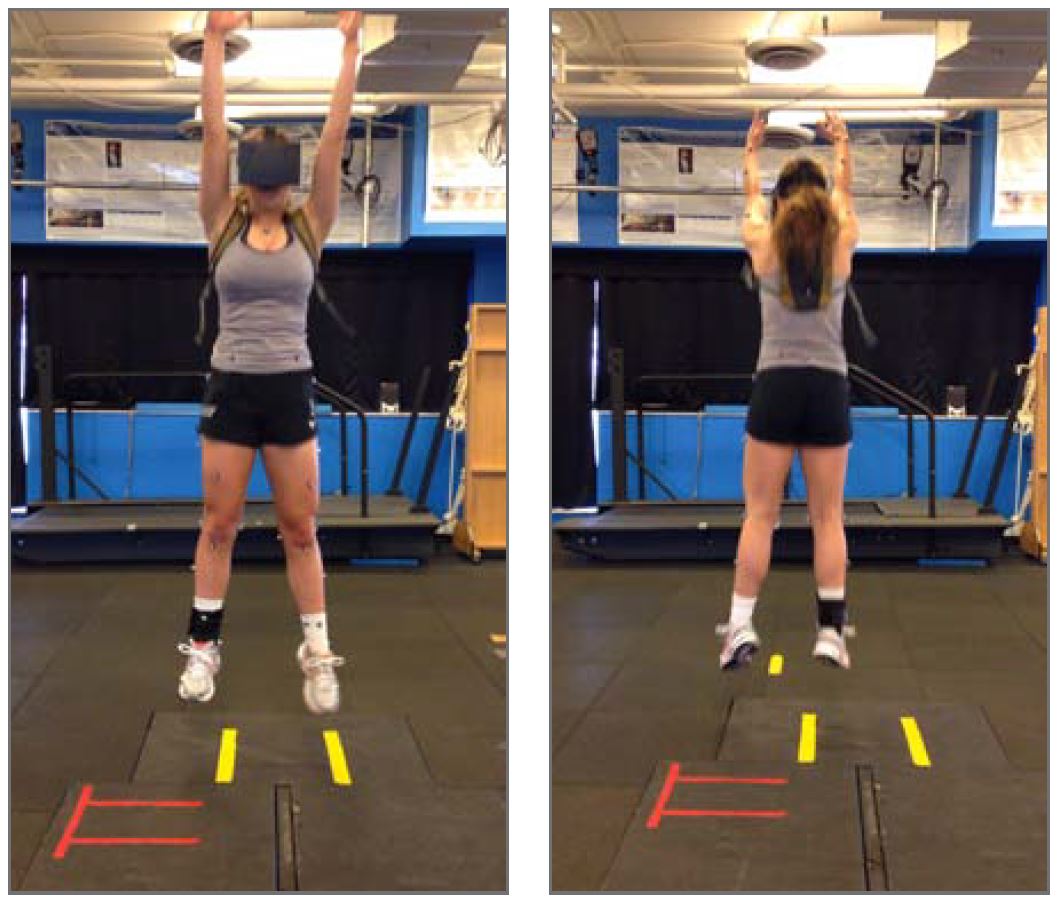
An athlete going up for a basketball rebound while in the TEAM VR system
MAK's DI-Guy software provides the artificial intelligence (AI) engine to drive three key immersion components for athletes, patients and practitioners when inside the virtual environment: (1) Strategic immersion, (2) social immersion, and (3) narrative immersion. Strategic immersion is utilized to mentally engage the user in the simulation and is made up of a combination of immediate, physical responses and more cerebral, cognitive decisions that underlie the overall strategies the user must adapt to complete sport-scenario tasks. Social immersion engages the user with other non-player characters that may be controlled by either AI or by another human that is sharing the virtual environment with the user. If it is difficult for the user to tell the difference between a human-driven or a computer-driven character, the social immersion is high. Finally, the narrative immersion is used to build a story that the user can become invested in and dictates how much he or she cares about the additional non-player characters and overall task goals. Together, these three components encourage real-world-like performance that is transferable to the real world.
“DI-Guy supplements our own in-house customized environments and scenarios. The technology provides full scenario customization with drag-and-drop commands that also integrate into Unity 3D.”
- Adam KIEFER, PhD Director, TEAM VR Laboratory
Want to learn more about the integral pieces of a simulation and their levels of fidelity? See The Tech-Savvy Guide to Virtual Simulation. Interested in a demonstration?
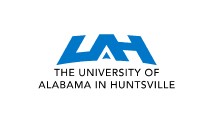 University of Alabama in Huntsville Recreating the Battle of 73 Easting using VR-Forces
University of Alabama in Huntsville Recreating the Battle of 73 Easting using VR-Forces
University of Alabama in Huntsville Uses MAK’s VR-Forces to Recreate the Battle of 73 Easting
MAK’s modeling and simulation software enhances students’ learning of the Persian Gulf War battle
The University of Alabama in Huntsville (UAH) is using MAK’s VR-Forces simulation software to recreate the Battle of 73 Easting, a major United States victory during the 1991 Persian Gulf War, enhancing its students’ learning experience. With VR-Forces, graduate students at UAH have achieved increasingly accurate replication of the historical results.
The simulations are directed by Mikel D. Petty, Ph.D, Associate Professor of Computer Science and Senior Scientist for M&S, Information Technology, and Systems Center at UAH.
“The Battle of 73 Easting is arguably the best-documented battle in U.S. history, which makes it a perfect application for both simulation analysis and historical study,” said Dr. Petty.
“Then-Capt. H.R. McMaster’s Eagle Troop of the Second Armored Cavalry Regiment aggressively engaged a much larger Iraqi armored force, destroying a large part of it in only twenty-three minutes. Simulation improves our ability to study the tactics of Eagle Troop and the rest of the regiment from a historical perspective, and recreating historical events in simulation provides insight into the accuracy and capabilities of the simulation.”
Engineers, test pilots, and air traffic controllers can work together, regardless of location, via a standard and holistic interoperability solution. This avoids the disruption and expense of moving into a new external facility and allows research facilities, airports, and others to connect to the platform.
VR-Forces is MAK’s complete simulation solution software. It is a powerful and flexible Computer Generated Forces platform that populates simulated synthetic environments with battlefield entities. Users can create scenarios full of custom, lifelike entities with specific behaviors, making it an ideal platform for training and education. The VR-Forces software also allows students to alter the parameters of the battle and compare simulation results with historical events. This year, under Dr. Petty’s guidance, his students will be investigating the change in outcome given a notional scenario in which the Iraqi forces were able to use modern T-14 Russian Armata battle tanks in 1991.
“This is a great application of VR-Forces,” said Dan Schimmel, former President and CEO of MAK. “We’re thrilled to see a famous battle simulated and analyzed by Dr. Petty and his students at the University of Alabama in Huntsville.“
“MAK has been very accommodating in allowing my students to use VR-Forces for their academic projects,” said Dr. Petty. “The intuitive nature of their graphical user interface and the accuracy of their simulation results make VR-Forces an excellent technology to enhance learning for modeling and simulation students.”
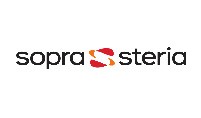 SopraSteria Sharing the Virtual Sky with the MAK RTI
SopraSteria Sharing the Virtual Sky with the MAK RTI
Sopra Steria picks the MAK RTI to power the interoperability of the Shared Virtual Sky
Collaborative innovation creates a virtual solution for aviation simulation and modeling
The volume of air traffic is escalating rapidly worldwide. Policymakers in Europe are looking at ways to balance this growth with the needs of air safety, environmental concerns, security needs, and economic competitiveness.
In response to this need, the European Commission set up the Single European Sky (SES) initiative to meet future airspace capacity and safety needs. The SESAR (Single European Sky Air Traffic Management Research) program is the technological and operational arm, tasked with building the future European air traffic management system.
SESAR seeks to predict, model, and manage aviation challenges. However, the bespoke simulation equipment required to achieve a high level of accuracy is both complicated and expensive. Therefore, Europe’s aviation industry sought a more cost-effective and collaborative way to approach this.
The Shared Virtual Sky solution
Sopra Steria, a leader in IT integration, has been providing intelligent transport systems for more than 40 years. In collaboration with a number of aviation industry partners, Sopra Steria took charge of architecture and operations behind an innovative research and development project aimed at responding to this industry-wide need.
The project successfully delivered the first European airspace simulation platform. This is now a commercial service that is being used by a number of organizations. Named Shared Virtual Sky, it enables the interconnection of aviation company systems, particularly airborne (cockpit) and ground navigation (air traffic control) systems. Participants connect their simulators to a high-fidelity real-time environment that supports specific flight simulations in rapidly changing conditions.
Engineers, test pilots and air traffic controllers can work together, regardless of location, via a standard and holistic interoperability solution. This avoids the disruption and expense of moving into a new external facility and allows research facilities, airports, and others to connect to the platform.
Sopra Steria chooses the MAK RTI
Sopra Steria chose the ![]() MAK RTI as the linking software because of its stability, its ability to work in a Wide Area Network (WAN) environment, and its adherence to the HLA IEEE 1516 specifications. The MAK RTI enabled Sopra Steria to speed up the development of the middleware layer (the “interoperability layer”) of this multi-partner Air Traffic Management simulation.
MAK RTI as the linking software because of its stability, its ability to work in a Wide Area Network (WAN) environment, and its adherence to the HLA IEEE 1516 specifications. The MAK RTI enabled Sopra Steria to speed up the development of the middleware layer (the “interoperability layer”) of this multi-partner Air Traffic Management simulation.
“Performance, quality, and stability are just three reasons that made us choose the MAK RTI. The support of Antycip Simulation, MAK’s reseller and partner in Europe, was another asset during implementation and deployment, providing specific customer updates when needed in our native language,” stated Jean Lingueglia, Shared Virtual Sky project leader at Sopra Steria, Spain.
Antycip Simulation is an expert provider of simulation, modeling, display solutions, and related services. Antycip’s experience was crucial in the development process and integration of MAK products.
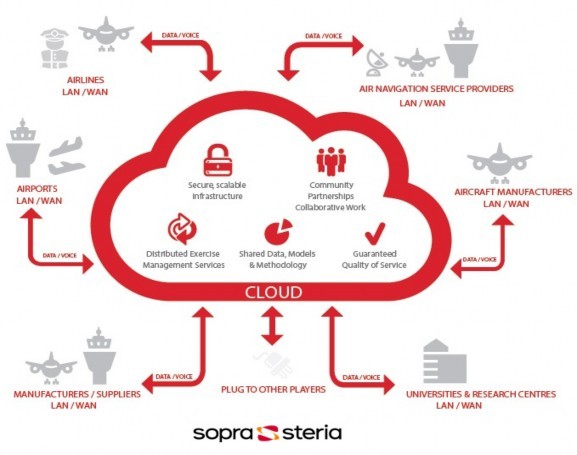
“We are very proud to work with Sopra Steria to develop the Virtual Sky as an open and interoperable ATM simulation solution. Our teams were efficient and benefitted from MÄK’s flexibility to help Steria deploy the MÄK RTI,” said Johan Besnainou, Director France and Spain for Antycip Simulation.“ Antycip Simulation and MÄK have been involved in simulation development for many years, and our focus is, and has always been, to help our clients easily and efficiently use our COTS products.”
Aircraft Manufacturers and ATC authorities in Italy, Germany, France, and Sweden are now using Shared Virtual Sky to derive a number of business and operational benefits. Theses include: improved ability to predict the position of an aircraft’s trajectory for better traffic management, enhanced security of aircraft traffic due to better demand and capacity balancing, and more realistic and relevant training for airport staff and aircraft operators. The ability to collaborate in a virtual environment accelerates innovation by enabling simulations using new air space management techniques and provides cost-effective validation and verification of planned and potential air traffic flow.
 Federal Aviation Administration selects VR-TheWorld for NextGen Projects
Federal Aviation Administration selects VR-TheWorld for NextGen Projects
The Federal Aviation Administration Chooses VR-TheWorld for NextGen Projects
The Federal Aviation Administration (FAA) is using its Next Generation Air Transportation System to transform the world of flight management and operation as we know it.
NextGen is an ongoing overhaul of our current National Airspace System (NAS), planned and demonstrated to enhance safety, reduce delays, and save fuel - all while diminishing aviation’s negative impact on the environment. The initiative uses new and existing technologies, including satellite navigation and advanced digital communications, to connect airports and aircraft in our NAS with continually shared real-time information.
The NextGen Integration and Evaluation Capability (NIEC) Laboratory is the FAA’s research platform to explore, integrate, and evaluate NextGen concepts through simulation activities.
It has chosen MAK’s VR-TheWorld as the streaming terrain server to stream imagery and elevation data into several of these Next- Gen simulations, including Aircraft Access to SWIM, or System Wide Information Management, (AAtS), and a Weather Technology in the Cockpit (WTIC) study.
Aircraft Access to SWIM (AAtS)
By promoting collaborative decision-making among all players in air traffic management, AAtS will increase the efficiency of air traffic operations by sharing relevant information with flight crews through a common information source. It will evaluate pilot situational awareness (SA), workload, and voice communications, in addition to the strategic planning of increased and more timely delivery of weather, flight, and aeronautical information to the cockpit through day-flight simulations. The FAA’s first study using VR-TheWorld, this human-in-the-loop experiment features the Dallas Fort Worth International Airport inset into the VR-TheWorld database.
Aircraft Access to SWIM is the flight deck extension of SWIM, which provides an open, flexible, and secure information management architecture for sharing NAS advisory data and enabling increased common situational awareness and improved NAS agility.
Weather Technology in the Cockpit (WTIC)
In an effort to better understand pilot decision-making in adverse weather conditions during flights through the Inter-tropical Convergence Zone (ITCZ), the FAA, in partnership with the National Centre for Atmospheric Research (NCAR), is developing a cockpit flight simulator for conducting experiments for NextGen pilot aids. They are using VR-TheWorld for a level 4 fixed-base flight training device. The goal is to determine how auxiliary avionics – in the form of an electronic flight bag, an electronic display system used primarily in the cockpit or flight deck– can boost the safety of transoceanic flights.
The study will include two airline crews flying simulated moonless night missions from Miami to Lima, Peru to investigate methods of displaying satellite-based weather in the cockpit. The fixed-base simulator used an Airbus A320 cockpit with sidestick, rudder pedals, flight management system, and ACARS thermal printer, but with reconfigurable displays featuring touchscreen controls to model other avionics and hardware.
Why VR-TheWorld
Delivered with a global base map, VR-TheWorld can be easily populated with custom source data through a web-based interface. The server can be deployed on private, classified networks to provide streaming terrain data to a variety of simulation and visualization applications behind a firewall. MAK’s most recent release, VR-TheWorld 2.0, adds the ability to store and stream feature data including roads, buildings, and trees to multiple applications simultaneously. The amount and quality of imagery and elevation data included with the server have been expanded, and also allows the user to add geospatial data to distribute in real-time.
By using VR-TheWorld, the FAA and the NIEC Laboratory have the most accurate feature and elevation data of the “virtual globe” at their fingertips, helping them to determine the most cost-effective and practical methods of bringing satellite-linked systems to all of the National Airspace System.
Want to learn more about the integral pieces of a simulation and their levels of fidelity? See The Tech-Savvy Guide to Virtual Simulation. Interested in a demonstration?
 IAI's MLM Division New Approach to Management Systems using VR-Link
IAI's MLM Division New Approach to Management Systems using VR-Link
Interoperability COTS tools by MAK at the Heart of MLM’s New Approach to Management Systems
For a recent Air and Land Command & Control Integrated Systems project, the team at MLM developed a new management approach that draws on the company’s expertise and existing customer infrastructure, as well as on currently available technology and advanced Information Technology (IT) tools.
The system is the result of over thirty years of significant knowledge and experience in designing and executing national and theater information C4I systems. It offers decision-makers complete command and control over their forces in peacetime, during times of crisis, in Operations Other Than War (OOTW), and in full-scale conflict. It generates a unified rapid and reliable Situation Picture (SP), while also automating data collection, transfer, processing, management, protection, and dissemination through secured communication networks utilizing Internet/Intranet Technology in near real-time. While efficiently and effectively utilizing the Armed and Paramilitary Forces and Civilian Organizations, MLM’s new management system also enables Central Headquarters to perform command and control functions at all times.
The building blocks for the MLM system are the Air Defense, Navy, Army, National Guard, and Police Control Systems that together provide an overall Integrated Common Situation Picture (ICSP). The other major components include databases, data management tools, information, and automatic data processing systems, decision support tools, display systems, and communication networks.
Based on the HLA standard, MAK's VR-Link is used as the basic infrastructure for the system’s main data bus connecting all data sources to all the operational stations, enabling the distribution of the Situation Picture, and smoothly merging simulated entities with real live entities. A VR-Link-based component is added to all the applications in the bus, including the operator’s stations with its well-designed map display.
Because HLA is implemented and well-supported by VR-Link and because the tool makes it easy and riskless to implement a distributed network data bus, the team at MLM took advantage of the HLA open standard for their management system.
“This case is a perfect example of a trend we see more and more, of merging M&S technology within C4I systems,” said Jacob Silbiger from Synergy Integration. “It opens new horizons for mission planning and readiness.”
MLM is a multifaceted design, development, and systems engineering organization. Its projects include Air and Missile Defense Systems, Advanced Avionics, Simulation and Training Systems, Crisis and Emergency Management Solutions, and C4I Air and Land Command & Control Integrated Systems. It is part of Israel Aerospace Industries (IAI) Ltd’s Systems, Missiles, and Space group. IAI is the largest aerospace and defense company in Israel, specializing in solutions for a wide range of air, land, sea, space, and homeland defense needs. IAI creates and supplies advanced systems for Israel’s Ministry of Defense and other groups worldwide.
Want to learn more about the integral pieces of a simulation and their levels of fidelity? See The Tech-Savvy Guide to Virtual Simulation. Interested in a demonstration?
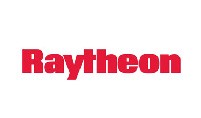 Raytheon IDS Wargaming to Stimulate C4I with a MAK Command and Staff Training System
Raytheon IDS Wargaming to Stimulate C4I with a MAK Command and Staff Training System
Wargaming System to Stimulate C4I System – Raytheon IDS
What’s at stake
Raytheon Integrated Defense Systems selected MAK to develop the simulation system to drive the wargaming & training component of their Command View C4I system that was subsequently delivered to a Raytheon customer.
The C4I system is used for national defense and simulated Command Post Exercises at the division, brigade, and battalion levels, providing opportunities for experimentation, doctrine development, and training.
How MAK Helped
MAK used VR-Forces' flexible architecture to develop and deliver a MAK Command and Staff Training System (MAK CST) to stimulate Raytheon’s C4I system. MAK CST acts as the synthetic environment for operational level training exercises — it feeds the C4I system with track data and reports from simulated forces.
Commanders and their staff lay down the Order of Battle and participate in the exercise using the same C4I system they would use in a real-world battle, while members of their organization direct the simulated forces by interacting with MAK CST in the simulation cell.
This two-year project resulted in MAK delivering a fully compliant system, on time, and within budget. Deliveries included documentation, training, comprehensive test procedures, and on-site integration support. The newly developed software has been integrated into the COTS VR-Forces product for ease of maintenance and upgrade. The system includes the VR-TheWorld Streaming Terrain Server.
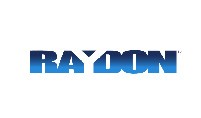 Raydon Company-level Constructive Training with MAK ONE
Raydon Company-level Constructive Training with MAK ONE
Raydon demonstrates company-level constructive training for the US Army Stryker community using MÄK products
Scalability can provide cost and fidelity advantages when it comes to training. When Raydon wanted to demonstrate constructive training at the company level to the US Army Stryker community, they used MAK’s COTS products to power and connect their simulation.
The result was a comprehensive demonstration of Raydon’s Combined Arms Operations that ties together live simulation, SAF driven capabilities and Fidelity’s Call for Fire trainer. The demonstration is scalable for exercises all the way up to company-level.
“MAK’s products allowed Raydon to support constructive training as a Stryker company. MAK’s simulation and Link products were integrated with Fidelity’s equipment and Raydon’s simulation engine. VR-Forces enabled Raydon to execute a Company level exercise with one live platoon and two puckster platoons,” said Greg Recker, Vice President of Business Development at Raydon. “Raydon’s experience with VR-Forces and the confidence built over that experience made the decision to use MAK an easy one. It was simple to integrate, and the toolset was easy to learn.”
Raydon’s demonstration of Combined Arms Operations trains a range of Army personnel, including platoon leaders, Fire Direction Center staff, Forward Observers, and Company Commanders. It allows for live platoon training while integrating Fidelity’s Call for Fire system. This expanded format provides a higher fidelity for the commanders by seamlessly including the relevant logistics and communication between the teams in training.
To populate a battle environment, Raydon used MAK’s VR-Forces Computer Generated Force (CGF) system. VR-Forces’ flexibility provided a battle environment that scaled from crew to platoon and company to combined arms, so they could easily connect Fidelity’s Call For Fire with the existing systems and train effectively. VR-Forces made it easy for participants to
puckster four stryker vehicles at a time and engage in larger combined arms operations without requiring additional personnel to run the simulation.
Red force actions were part of a pre-built multi-phase line scenario designed to stimulate the training. VR-Forces provided a rich library of constructive entities. The variety of vehicles, human characters, and behaviors allowed Raydon to generate sufficient realism to train Platoon leaders and the Company commanders for specific threats.
MAK’s Link products provided the needed interoperability and flexibility to seamlessly expand and distribute the training over different networks, using protocols including DIS and HLA. For this project, Raydon used VR-Forces to execute a company-level exercise with one live platoon and two puckster platoons.
MAK’s engineer-down-the-hall approach played a role in making the demo a success, as MAK engineers worked cohesively with Raydon to solve potential issues before they became problems.
“MAK was very open to helping make the project a success from a technical standpoint, and the knowledge and experience of their engineers was a resource always available to us,” said Greg.
The result was a comprehensive demonstration of Raydon’s Combined Arms Operations that ties together live simulation, SAF-driven capabilities, and Fidelity’s Call for Fire trainer. The demonstration is scalable for exercises all the way up to company level.
Want to learn about trade-offs in fidelity? See The Tech-Savvy Guide to Virtual Simulation?
Interested to see a demonstration?
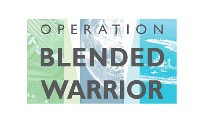 OBW Bringing Reliable Interoperability to Large Simulations with MAK ONE
OBW Bringing Reliable Interoperability to Large Simulations with MAK ONE
Bringing Reliable Interoperability to Large Simulations with MAK ONE
How MAK connected confederates to make a large simulation possible.
An engineer at a system integrator is asked to participate in Operation Blended Warrior (OBW) at I/ITSEC 2015. This complex simulation event involves 31 different organizations, with each assuming a role and connecting their simulator to the scenario. The exercise network requires the DIS 6 protocol, but the engineer’s simulators run HLA 1.3. OBW requires that all participants use a gateway for network security reasons.
Schedules are tight and there is limited time to do testing. Where can the engineer turn for an inexpensive out-of-the-box protocol solution that meets all the simulation requirements and just works?
What is OBW?
Operation Blended Warrior was an I/ITSEC special event organized by the National Training and Simulation Association (NTSA) and the US NAVY to explore the potential for live, virtual, and constructive capabilities in the defense and security sectors.
31 organizations from government and industry united to design a simulation exercise that would run on the show floor at I/ITSEC. It would demonstrate how individual capabilities existing within the community could be linked together to minimize costs and maximize the benefits of the live, virtual, and constructive approach to training and education.
The Capabilities
Each company was asked what capabilities they could contribute, and the response was impressive. (MAK’s contributions are noted in each category):
- Man-in-the-loop simulators, a.k.a. 1st person players
- Computer Generated Forces, a.k.a. SAF or Game Engines (VR-Forces)
- Infrastructure: Radio comms, video conferencing, cloud computing
- Networking technology (VR-Exchange)
- Integration support tools (MAK Data Logger)
- Tactical Display (VR-Vantage )
- Cyber attack models
- Medical simulations
The Storyline
| To integrate these simulation capabilities into a common exercise, the participants worked together to develop a fictional storyline to make sense of all these assets operating at the same time. They envisioned a country called Balboa, described as an ally of the United States, surrounded by hostile neighbors. Balboa would be rocked by a natural disaster, requiring both humanitarian assistance and homeland security. On day one of the simulation, the damage to the Balboan infrastructure is immense — the civilian population needs supplies, evacuation, and medical treatment. Hostile neighbors take advantage of the chaos and take over a power facility and commandeer commercial ships. In response, the allies airlift supplies to refugees, protect air corridors, provide close air support for vulnerable ground troops, mitigate a pirate attack, and intercept UAVs, all the while amphibious Marine units maneuver onto the shore to retake the powerplant. |
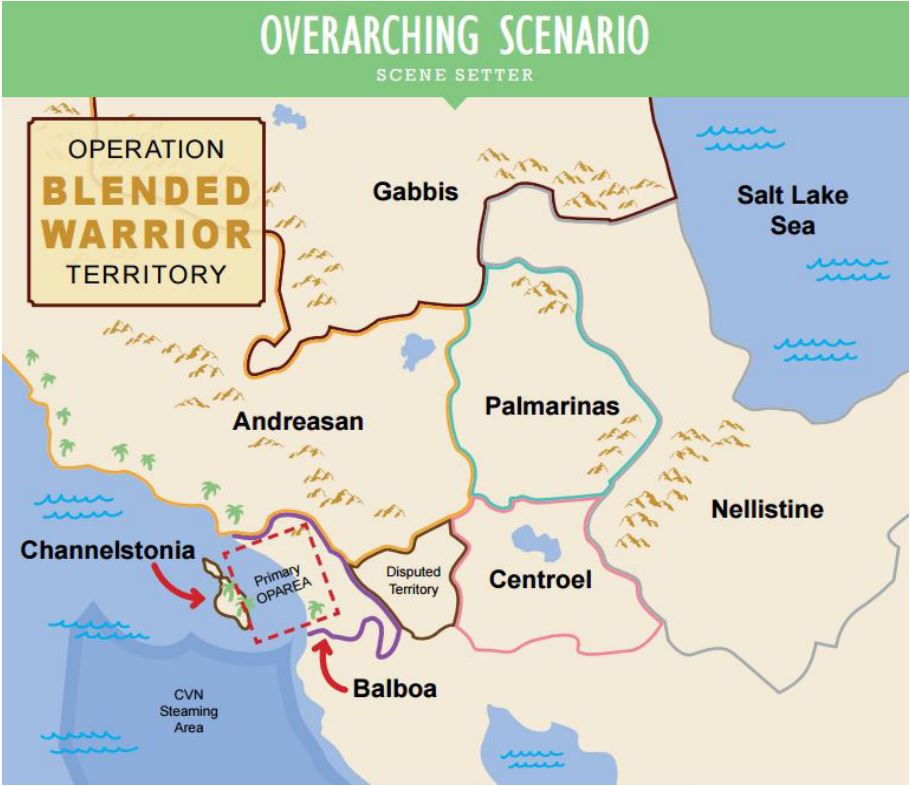 |
The Challenge
| It is difficult to connect this many different simulators and maintain a viable exercise network. A large number of players generating diverse traffic types on the network creates complexity, requiring a certain set of rules to govern the event. Because of a tight integration schedule and few testing opportunities, gateways were used not only as protocol translators but as a way of isolating a simulation from network traffic that might be harmful or reduce performance. A particular set of mandatory network configuration settings introduced a great deal of network complexity into the simulation environment and there was little time to make it all work smoothly. | 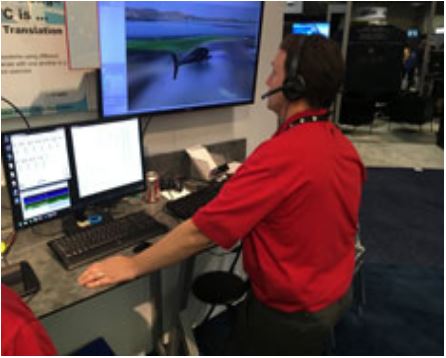 |
The Solution
| In addition to MAK, 10 other participants chose MAK’s VR-Exchange software to provide interoperability. With its combination of low cost, out-of-the-box usability, and reliability, it was a very popular solution. Participating organizations learned the value of COTS tools at different times during the lead-up to the event at I/ITSEC. Some chose to partner with MAK early on, and the process was very smooth for them. Others ran into difficulty during integration testing and switched to MAK’s solution shortly before the show. One even made it to the show floor before they realized that they may not be able to play without MAK’s assistance. When showtime arrived, VR-Exchange translated protocols between participants flawlessly, allowing the simulation to commence without any glitches or translation errors that could compromise its integrity and sense of realism. All of the vignettes in which MAK participated ran smoothly and Operation Blended Warrior was a success. |
 |
“The VR-Exchange product was great...I liked how stable the product was. Once set up, we left VR-Exchange running throughout the entire show. The product ran for the entire show without issue.”
“I’d like to congratulate [MAK] on such a great showing at OBW – a huge number of participants relied on MAK products for their success.”
—Two engineers that used VR-Exchange at OBW
To learn more about how we can help you create your ultra-realistic mixed-reality training environment, reach out today at
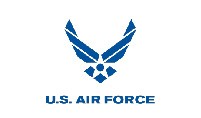 USAF & UK CAS Air Support Operations Center (ASOC)
USAF & UK CAS Air Support Operations Center (ASOC)
Air Support Operations Center (ASOC) Total Mission Training
What's At Stake?
The ASOC (Air Support Operations Center) Battlefield Simulation fills a crucial gap in USAF and United Kingdom Close Air Support (CAS) and airspace manager training. The system provides six squadrons with the capability to conduct total-mission training events whenever the personnel and time are available.
How MAK Helped
When the 111th ASOS returned from their first deployment to Afghanistan they realized the training available prior to deployment was inadequate. They sought an organic training capability focused on the ASOC mission that was low cost, simple to use, adaptable, and available now. With the assistance of MAK, they developed a complete training system based on MAK’s QuickStrike HLA-based simulation. Through more than two years of spiral development, incorporating lessons learned, the system has matured, and can now realistically replicate the Tactical Operations Center (TOC) in Kabul, Afghanistan, the TOC supporting the mission in Iraq, or can expand to support a major conflict scenario. The training system provides a collaborative workspace for the training audience and exercise control group via integrated software and workstations that can easily adapt to new mission requirements and TOC configurations. The system continues to mature. Based on inputs from the warfighter, new capabilities have been incorporated to add realism and simplify the scenario development process. The QuickStrike simulation can now import TBMCS Air Tasking Order air mission data and can provide air and ground tracks to a common operating picture; presented through either TACP CASS or JADOCS.
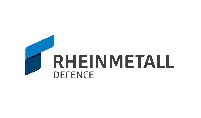 Rheinmetall-Canada Air Defense Operations Using MAK ONE for Decision-Making Training
Rheinmetall-Canada Air Defense Operations Using MAK ONE for Decision-Making Training
Air Defense Operations Using MAK ONE for Decision-Making Training
What's At Stake?
Rheinmetall Canada delivered an Air Defense Operations Simulation (ADOS) for the Dutch Army to be used for decision-making training of the staff of the air defense units responsible for Command and Control (C2). The Dutch Army is fielding new Ground Based Air Defense Systems (GBADS) from Rheinmetall and integrating these with Short Range Air Defense (SHORAD) systems, requiring new training systems for tactical decision-making as opposed to purely operation training. The ADOS system is also being used as an aid in the development of air defense Doctrine, Tactics, Techniques, and Procedures (DTTP).
How MAK Helped
The training system comprises a simulation network connected to a copy of the operational C2 system.
VR-Forces, MAK’s simulation solution, provides scenario generation and modeling of ground and air threats and blue force including the mobile GBADS. VR-Vantage is used as the primary interface for the role players which include the Stinger Weapon Platform platoons, the Norwegian Advanced Surface to Air Missile System (NASAMS) fire units, and opposing forces.
All positions are connected via the High Level Architecture (HLA) through the MAK High Performance RTI. Students, making up the Staff platoon, are at copies of the operational C2 system. The MAK Data Logger supports After Action Review.
“MAK’s VR-Forces and VR-Vantage combination of providing out-of-the-box capabilities with a powerful API for easy customization made them the ideal choice as the simulation and visualization component of the ADOS System. The technical capabilities of MAK’s products coupled with their excellent reputation for unsurpassed customer support made the decision to team with MAK an easy one,” said Ledin Charles, ADOS Program Manager, Rheinmetall Canada.
 NASA Airspace Management Project Wins, Grows with the MAK RTI
NASA Airspace Management Project Wins, Grows with the MAK RTI
NASA Project Wins, Grows with the MAK RTI
As aviation technology has improved, commercial air traffic has increased significantly, requiring better airspace management techniques. In an attempt to develop better air capacity, safety, and flexibility, NASA’s Air Traffic Operations Laboratory (ATOL) used a massive simulation environment called Air and Traffic Operations Simulation (ATOS) to explore better techniques. As the project’s success lead to its growth, NASA required a licensing option that would be easily scalable in a simulation that is ever-expanding.
NASA originally needed a tool that could effectively communicate and maintain all the entities involved in its complex, multi-laboratory, simulation that includes 400+ workstation-based high-fidelity aircraft simulators networked together. The simulation would eventually demand a creative, flexible solution so that licensing restrictions would not hinder its development.
The MAK Advantage:
MAK offers commercial-off-the-shelf (COTS) technology to facilitate Air Traffic Management simulations, backed by a company with an “engineer down the hall” philosophy to help organizations creatively solve their implementation issues. The MAK RTI has been used by ATOL for over a decade to enable their High Level Architecture (HLA) federations to rapidly and efficiently communicate the positioning and actions of entities in the ATOS simulation. It was also used to communicate with external laboratories at NASA LaRC, NASA Ames Research Center, FAA and other compliant facilities. As the simulation’s success led to the growth in the number of federates and labs involved in the simulation, NASA’s needs changed. The ATOL required a way to use unlimited instances of the MAK RTI, and needed to do it in a way that would be cost-efficient. MAK’s “engineer own the hall” philosophy played a big role in ensuring success, as we worked out a custom licensing model to meet their needs and ensure that MAK would continue to play a role in the success of the ATOL.
We were able to reach Glover Barker of NASA Langley Research Center for comment: “At NASA Langley Research Center, we have used the MAK RTI libraries since 2005. Our Airspace and Traffic Operations Simulation (ATOS) uses High Level Architecture (HLA), so we initially tried an open-source HLA solution. But the quality and reliability were not adequate, so we purchased RTI from MAK. MAK's RTI implementation conforms well to HLA standards, so we could easily substitute MAK RTI for the open-source solution. We have been satisfied customers ever since.”
“MAK has steadily improved their product in every new release. MAK's technical support always responds quickly and helpfully when we have questions or problems. When needed, they have sent staff to our site to inspect our environment and made recommendations to change our configuration. In the cases when we experienced a bug because of the unique way we used their software, MAK has diligently provided fixes for our problems. When we needed a new licensing scheme to fit our usage model, MAK delivered.”
Want to learn more? Have a look at the MAK RTI page for more information. Interested in seeing a demonstration?
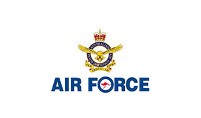 DSTO's Air Defense Battle Management with MAK ONE
DSTO's Air Defense Battle Management with MAK ONE
DSTO's Air Defense Battle Management with MAK ONE
What's At Stake?
The Air Defence Ground Environment Simulator (ADGESIM) was developed by the Defence, Science and Technology Organization (DSTO) to evolve Royal Australian Air Force (RAAF) training systems and prepare personnel for network-centric operations. ADGESIM, a network-centric aerospace battle management application, is a major component of the RAAF strategy to adopt distributed simulation technology.
How MAK Helped
ADGESIM is comprised of three applications developed by DSTO and YTEK (DSTO engineering contractor) in C++ and closely integrated with VR-Forces and VR-Link. The ADGESIM Pilot Interface is used to create and fly simulated aircraft entities. All high-resolution entity modeling is done in the background by VR-Forces and ADGESIM entities have been proven compatible with both Australian and US Navy distributed simulation environments. The RAAF routinely runs scenarios with eight Pilot Interface workstations simultaneously without taxing the PC-based ADGESIM system.
Jon Blacklock, Head, Air Projects Analysis, Air Operations Research Branch of DSTO, explained that “his research program had identified VR-Forces and VR-Link as the only products with a sufficiently open architecture and useable programming interface to support rapid prototyping and development. Using a mixture of MAK’s COTS tools and custom-built “thin client” applications, we were able to create ADGESIM in less than six months, for around half the original budget.”
“VR-Forces’ flexibility secured its place in our development,” said Blacklock. “The ease of customization and the API were among the biggest reasons we chose it. At the start, it lacked a few features on our wish list, but MAK’s outstanding tech support helped us fill in the gaps. During the six-month development, MAK redeveloped its applications and added features in parallel with our development. It is a testament to MAK’s professional approach that when we got the release version of VR Forces, we needed just two weeks prior to installation in the first Regional Operations center. We plugged in our applications and everything just worked.”
 ADVENTUREtech Light Armored Vehicle Demonstrator
ADVENTUREtech Light Armored Vehicle Demonstrator
Light Armored Vehicle Simulator Demonstration
Arriving on the floor to setup for a trade show, Ivan finds himself in a stressful situation: Only 4 hours for setting up a demo of a collaborative Light Armored Vehicle (LAV) simulator. The new partner, ADVENTUREtech, just introduced a display system that needs to become part of the simulation.
The demo includes 4 different user stations:
- LAV Driver in an ergonomic seat inside a 3-channel CAVE display
- Gunner using a game controller with a single monitor
- Commander using the Oculus VR headgear
- Observers on a monitor to display what the Commander sees
"MAK's product suite transformed a booth with a display system into a fully-functional, team-oriented training demonstration."
Scroll down to watch animation based on the Tech-Savvy Guide to Virtual Simulation
The MAK Advantage:
MAK used its Light Armored Vehicle (LAV) simulator built on VR-Forces and VR-Vantage to set up this system.
VR-Vantage is used to provide trainees with high-detail role-specific visual scenes. VR-Vantage's multi-channel distributed rendering architecture makes it easy to configure a continuous scene across a CAVE display. The CAVE is a form of display that displays scenes onto three to six sides of a cube. CAVEs provide a wide viewing angle that makes an immersive environment for the Driver without the expense of edge-blended dome displays. This display is a good match with the ergonomically positioned driver controls that make driving natural and leave the operator's attention on the mission.
The Gunner's view is presented on a single monitor and operated with a commercial game controller. The gunner IG supports daylight visual and night vision scenes, toggled by a switch on the game controller. This lower fidelity interface is appropriate if the gunner’s tasks focus on targeting decisions and communicating with the commander but could be implemented with higher fidelity interfaces if shooting skills were important.
The Commander is using the Oculus VR headgear to present a fully immersive display that is reactive to his head position and movements. A video monitor is used to show observers what the Commander is seeing.
The VR-Forces simulation engine is hosting the light armored vehicle ownship simulation. It uses CM Lab’s Vortex physics engine to model the vehicle and gun dynamics. Because it’s based on VR-Forces simulation framework, it can coordinate user inputs from each of the operators, provide terrain access to the Vortex models, and handle the weapons effects, sensors, and damage models for the vehicle.
The terrain used is Simthetiq’s SUROBI VTE, a terrain database hand built from source data from the Surobi valley in Afghanistan. This database provides high-performing models with close-up detail of a typical Afghan village.
The virtual simulator is connected through the network, using VR-Link, to two other simulations. VR-Forces CGF, which simulates neutral, friendly, and opposing force entities. VR-Forces enables instructors to pre-plan training scenarios where non-player AI move and interact based on mission plans, reactive tasks, and triggers based on the actions of other entities in the simulation. Instructors and role players can interact at several levels: they can give squad leaders tasks and have the members of the squad follow those instructions, they can command individual entities, or take first-person control of vehicles and human characters.
DI-Guy Scenario can add additional human characters to the simulation that model the patterns of life in the village and react to the actions of the LAV.
VR-Forces, VR-Vantage, and DI-Guy Lifeform Server include MAK’s networking technology. VR-Link’s protocol-independent API allows all three applications to communicate through industry standard High Level Architecture (HLA) and the Distributed Interactive Simulation (DIS) protocols, including HLA 1.3, HLA 1516, HLA Evolved, DIS, and DIS 7. The MAK Data Logger records and plays back all the network simulation traffic for after-action review and analysis. The MAK RTI (runtime infrastructure) is available when connecting to HLA federations using any of these SISO standard protocols: HLA 1.3, HLA 1516, and HLA Evolved.
Want to learn more about virtual simulation?
Interested to see a demonstration?
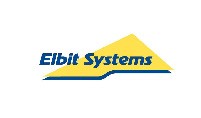 Dutch Army Command and Staff Trainer using MAK ONE
Dutch Army Command and Staff Trainer using MAK ONE
Dutch Army Command and Staff Trainer using MAK ONE
What's At Stake?
In this use case, the trainees are military commanders who interact with the real C4I interface, which is configured to be in a training mode. Role players contribute to the simulation scenarios. And white-cell operators manage the exercise making sure the scenarios stay on track.
How MAK Helped
Working as a subcontractor to Elbit Systems, MAK delivered a modified version of VR-Forces that was used as the simulation engine for a Command and Staff Trainer for the Dutch Army. VR-Forces is used for scenario authoring, simulation execution, and as a role-player station for white-cell operators and instructors.
VR-Forces-simulated entities, and other objects, are displayed on the C4I system's map. Elbit, the developers of the C4I system, wrote a Gateway application using VR-Link and the VR-Forces Remote Control API that translates between the HLA protocols spoken by VR-Forces, and the C4I protocols used by the operational C4I system.
The Dutch system employs several VR-Forces simulation engines to share the load of simulating several thousand objects.
This project focuses on the tactical level more than the operation level. For example, it had requirements for 3D views (UAVs camera displays and "pop the hatch" out-the-window views for operators playing the role of company commanders), thus, much of the actual simulation is at the entity level rather than the more constructive true aggregate level.
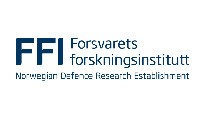 Norwegian Defence (FFI) Experimentation with C2 Systems using VR-Forces
Norwegian Defence (FFI) Experimentation with C2 Systems using VR-Forces
Norwegian Defence Research Establishment uses VR-Forces for CST Experimentation
What's At Stake?
The Norwegian Defence Research Establishment (FFI) has established a demonstrator for experimentation with command and control information system (C2IS) technology. The demonstrator is used for studying middleware, different communication media, legacy information systems, and user interface equipment employed in C2ISs.
How MAK Helped
MAK’s VR-Forces, computer generated forces simulation toolkit is a component of the demonstrator serving as the general framework for rapid development of synthetic environments. It is used for describing the scenario and representing the behavior of most of the entities in the environment. The demonstrator’s flexible and extendable HLA-based synthetic environment supports VR-Forces participation as a federate in the HLA federation, allowing it to exchange data with entities and systems represented in external simulation models.
 USAF Networking Simulation Environments to C2 Systems with MAK ONE
USAF Networking Simulation Environments to C2 Systems with MAK ONE
USAF Networking Simulation to C2 Systems with MAK ONE
What's At Stake?
Large investments have been made in developing simulation systems that model and simulate various aspects of the military environment. Networking these together enables building systems-of-systems that model larger and more complete operational scenarios. Connecting these to operational C2, C3, C4I, and Mission Command systems allows commanders and their staff to have experiential learning opportunities that otherwise could not be achieved outside of actual conflict.
How MAK Helped
MAK’s VR-Link interoperability toolkit is the de facto industry standard for networking simulations. MAK’s implementation of the HLA run time infrastructure (RTI) has been certified for HLA 1.3 and HLA 1516, and is currently being certified for HLA 1516:2010. The MAK RTI has been used in many federations, some with over a thousand federates and tens of thousands of simulated entities. MAK’s universal translator, VR-Exchange, has been sold as a COTS product since 2005 and was first developed for and used on the US Army Test and Evaluation Command (ATEC) Distributed Test Event 2005 (DTE5) linking live, virtual and constructive simulations for the first time. Since then it has been used on many programs and at many sites to link together live (TENA), virtual (HLA), and constructive (DIS) simulations.
MAK has interfaced Battle Command to operational Command and Control Systems including C2PC, Cursor on Target, and JADOCS for the USMC and USAF. Previously we developed an interface for FBCB2.
The US Air Force selected MAK interoperability products for use on the Air Force Modeling and Simulation Training Toolkit (AFMSTT) program and we have successfully completed delivery. The MAK tools include the new MAK WebLVC Server, VR-Exchange, VR-Link and MAK Data Logger. Based on the Air Force's Air Warfare Simulation (AWSIM) model, the AFMSTT system enables training of senior commanders and staff for joint air warfare and operations. MAK's tools are being used to help migrate the AFMSTT system to a service-oriented architecture based on High Level Architecture (HLA) interoperability and web technologies.
 USMC Tactical Operations Training
USMC Tactical Operations Training
Tactical Operations Training – USMC MCTOG
What's At Stake?
The U.S. Marine Corps Tactical Operations Group (MCTOG) uses advanced human simulation, ECO Sim to model blue forces, oppositional forces, and civilian pattern-of-life to train captains two weeks prior to deployment in Afghanistan. ECO Sim trains IED defeat missions simulating sophisticated human networks of financiers, bomb makers, safe houses, leaders, and emplacers. These IED networks operate within a larger backdrop of ambient civilian behavior: farmers in fields, children attending school, families going to marketplaces and religious services. The Marine captain commands searches, patrols, and detentions, all while monitoring the battlefield using ISR data provided by UAS and stationary cameras. In addition, ECO Sim has a sophisticated report capability, mimicking the way Marines will actually convey and receive information in the battlefield.
 Colombian National Government Understanding, Preparing for, and Combating Cyber Attacks with VR-Forces
Colombian National Government Understanding, Preparing for, and Combating Cyber Attacks with VR-Forces
The Battlefield is Evolving
The Increased Threat of Cyber Attack Affects Strategic Decision Making
As technologies continue to advance and become more deeply ingrained in modern life, threats of a crippling cyber attack or electronic warfare (EW) become increasingly probable. In an attempt to mitigate these risks, the Colombian national government (represented by the Ministry of Information Technology), the Higher War School in Colombia, and ITM Consulting Company joined forces to explore the role simulation plays in understanding, preparing for, and combating cyber attacks.
To build electronic warfare scenarios, the organizations needed a tool that could create and model elements vulnerable to cyber attacks, such as radar systems, military and civilian entities, and communication systems; they chose MAK’s VR-Forces simulation software tool for the job. VR-Forces not only allowed them to create scenarios to play out different threats in different environments but also gave them the freedom to redesign the User Interface (UI) to match specific scenario needs. The group conducted three major cyber attack scenarios, which they are using to create response strategies.
In the first scenario, VR-Forces simulated two aircraft teams, where the red team was given a mission to use scanners and jammers to alter the frequency on the blue team’s radar systems; doing this enabled the red team to use attack aircraft to undermine the blue team’s defense system (see Figure 1).

Figure 1: Illustration of a Radar Attack
The second scenario uses VR-Forces to simulate an electronic warfare attack on the Colombian oil infrastructure, a victim of frequent terrorist attacks. In this exercise, the red team was instructed to alter the readings on specific valves on a pipeline to ignite fires. Additionally, attacks on the blue team’s surveillance systems (unmanned aircraft) set out to deter the blue team’s response (see Figure 2).
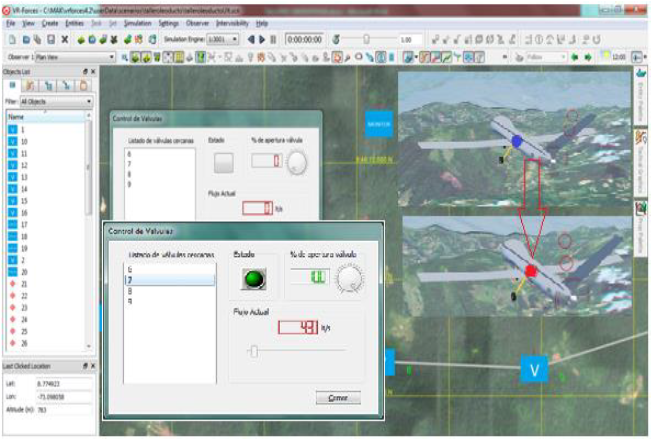
Figure 2: Cyber Attack on a Colombian Oil Infrastructure
A third scenario highlights the danger to the civilian population if the turbines in a hydroelectric plant are compromised through a cyber attack. The red team in this situation instigates drastic variations in water levels at the plant that in turn disrupt the power and energy generated to the nearby town. The power and energy disruptions bring about detrimental consequences for the simulated town (see Figure 3).
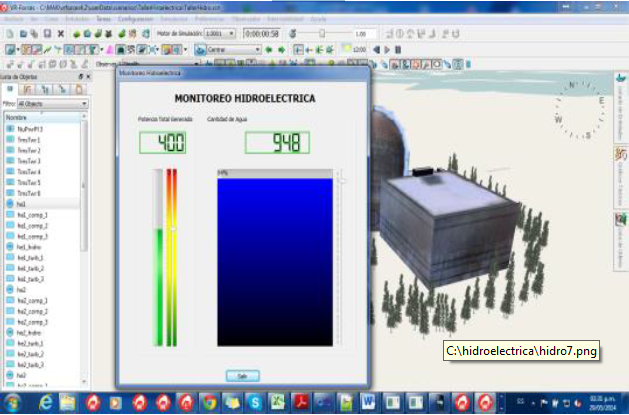
Figure 3: Cyber Attack on the Colombian Critical Infrastructure
The exercises using VR-Forces have contributed to research and development efforts led by the Department of Telematics ESDEGUE, and in particular its line of research in Cybersecurity and Cyber Defense.
 The Naval Postgraduate School MOVES Institute Relies on MAK ONE
The Naval Postgraduate School MOVES Institute Relies on MAK ONE 
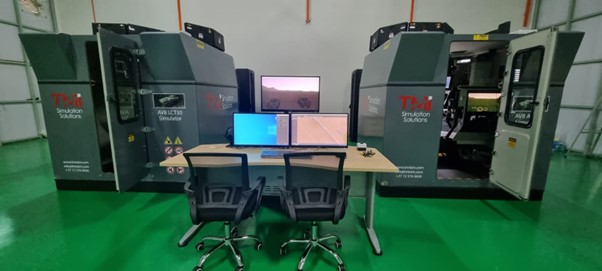
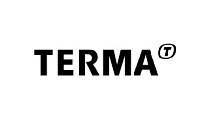 Terma/Royal Danish Navy Naval 3C System Upgrade with VR-Forces
Terma/Royal Danish Navy Naval 3C System Upgrade with VR-Forces
